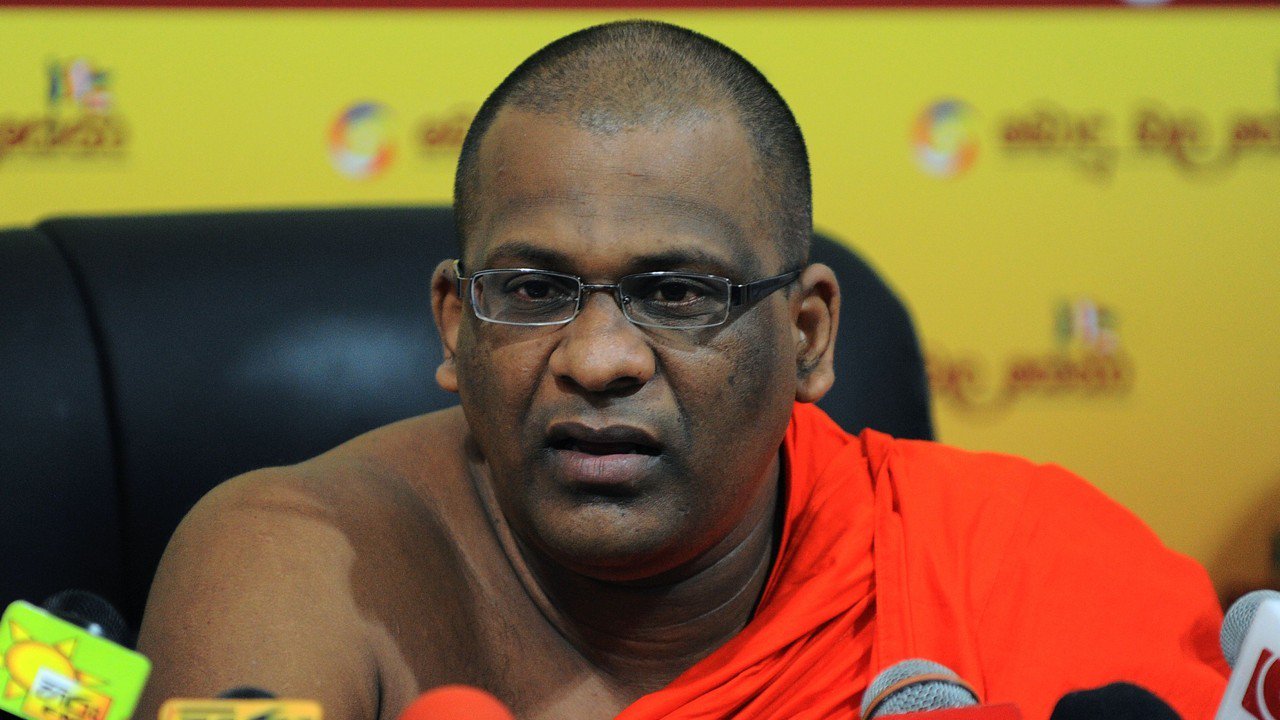Reviews
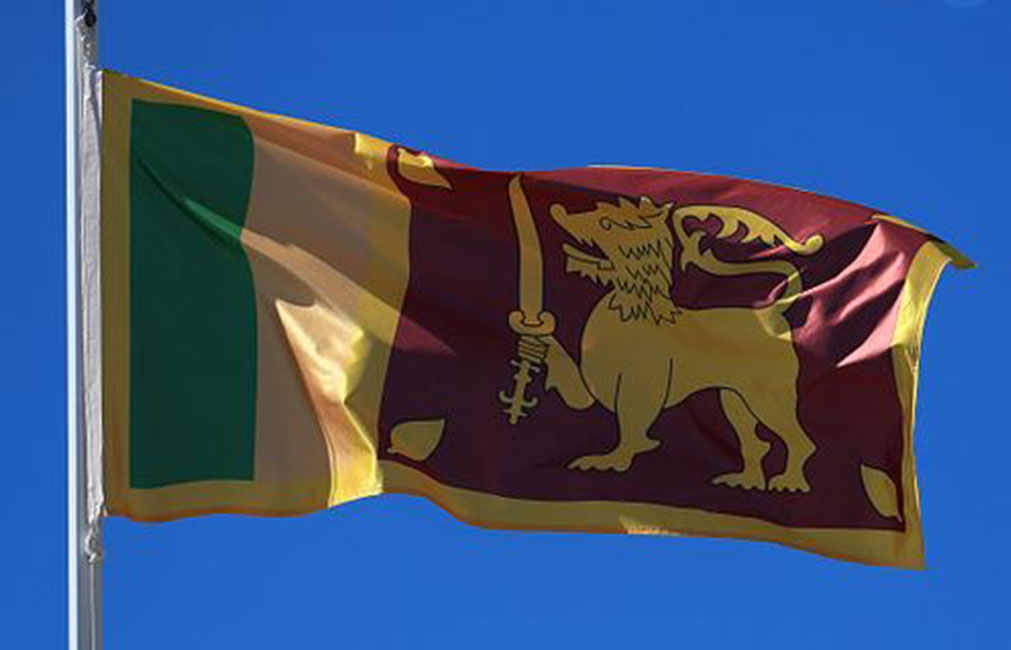
An evaluation of Sri Lanka’s democratic credentials
By Ana Pararajasingham
On Monday, Sri Lanka’s Court of Appeal issued an interim injunction suspending the government of Mahinda Rajapaksa, his ministers, deputy ministers, and state ministers from continuing to function in their respective portfolios. This has reversed, albeit temporarily, President Maithripala Sirisena’s attempt on October 26 to re-install a government under former president Rajapaksa as prime minister.Earlier, Sirisena’s attempt to dissolve Parliament in the absence of a majority supporting Rajapaksa was stayed by the Supreme Court until December 7. These actions no doubt demonstrate the independence of the country’s judiciary, an essential attribute of a democracy.
Sri Lanka’s constitutional crisis was triggered by Sirisena appointing former president Mahinda Rajapaksa as the country’s new prime minister on October 26, in effect firing the sitting prime minister, Ranil Wickramasinghe. The removal of a sitting prime minister is a clear violation of the country’s constitution, that is if one is to rely on the English version of it. This is because the Sinhala version of the constitution appears to provide the president with the power to remove the prime minister.
In such circumstances, where there is a discrepancy between the Sinhala version and the Tamil or English versions of the constitution, the law clearly stipulates that it is the Sinhala version that will prevail. It is argued that the import of the Sinhala version is the same as the English version and the discrepancy is attributable to the chaotic legislative process by which the 19th Amendment to the constitution defining the president’s powers was enacted in 2015.
However, this is yet to be tested in court. In view of the independence demonstrated by the judiciary to date, it may well result in actions that resolve Sri Lanka’s constitutional crisis.
Should that occur, much will be made about Sri Lanka’s democracy and its restoration. This is because from the very beginning Sri Lanka’s constitutional crisis was framed as a challenge to democracy.
Indeed, Sri Lanka is widely described as one of Asia’s oldest democracies. No doubt this perception is backed by Sri Lanka’s current constitution, which was enacted in 1978, and its previous constitutions, the founding 1948 charter and the 1972 republican constitution, being underpinned by features associated with democracy, that is, parliamentary assemblies, periodic elections and an independent judiciary.
But do they make Sri Lanka a democracy? The country’s laws providing supremacy to the Sinhala version of the constitution should surely cause some niggling doubts about Sri Lanka’s democratic credentials.
Ethnocracy not democracyUpon a close examination of Sri Lanka’s constitutions enacted in 1948, 1972 and 1978, it becomes obvious that Sri Lanka cannot be regarded as a democracy but has to be considered an ethnocracy. Ethnocracy basically means “government or rule by an ethnic group” or ethnos, and more precisely rule by a particular ethnos in a multi-ethnic situation where there is at least one other significant ethnic group.
Indeed, since it was granted its independence by Britain in 1948, Sri Lanka has emerged as a typical ethnocracy in which the state apparatus is appropriated by the dominant ethnic group to further its own interests, power and resources. In Sri Lanka’s case, Sinhala Buddhist ethnicity is the key to securing political power. As such, resolving the constitutional crisis is not a matter of restoring democracy but of restoring ethnocracy.
Indeed, over the years Sri Lanka’s ethnocracy has been strengthened by constitutions enacted by succeeding Sinhala-dominated governments. It is not surprising therefore that Oren Yiftachel of Ben-Gurion University and Asad Ghanem of the University of Haifa, in an article titled “Understanding ‘ethnocratic regimes: the politics of seizing contested territories,” identified Sri Lanka as an ethnocratic state.
An ethnocratic state, however, is not completely devoid of democracy. But this democracy is confined to the dominant ethnic group. As pointed out by James Anderson of Queens University Belfast, within an ethnocratic state the dominant ethnos “typically demands democracy, actively wants it – at least for itself.”
“Thus these national regimes are not simply authoritarian: they typically have parliamentary assemblies and periodic elections, for instance, and perhaps a (sometimes ostensibly?) independent judiciary, and a (supposedly?) free media. These can give the appearance of ‘ordinary democracy’ but they hide a ‘deeper structure’ which is profoundly anti-democratic in that the democracy applies only or mainly to politics within the dominant ethnos, not to the demos of all the people in the state territory.
“Rule is mainly or solely by members and representatives of that ethnos, it is they who are in charge, making the major decisions: ethnos and demos are conflated but the ‘democracy’ is disproportionately and sometimes exclusively available to the favored ethnos. And it is this political cleavage between the ethnic groups which defines the character of the state as ethnocratic rather than democratic.”
Sri Lanka exhibits all of the above.
Sri Lanka’s constitution(s)
The evaluation of Sri Lanka’s current constitution and the previous two constitutions by Andrea Iff, a Swiss academic and political scientist, confirms that all of Sri Lanka’s constitutions have been based on ethnocratic principles.
In a chapter titled “Constitutional Accommodation vs Integration in Sri Lanka” in Sri Lanka: 60 Years of Independence and Beyond, Iff makes it clear that the so-called democracy that is being associated with Sri Lanka is illusionary. Having painstakingly examined Sri Lanka’s 1948, 1972 and the 1978 constitutions, she concludes that all of Sri Lanka’s constitutions have been based on a “control model” where the majority segment dominates and reduces all other segments to a position of subordination.
Sri Lanka’s flag is a powerful symbolic reiteration of this truth. The flag is dominated by a lion, the ancient symbol of the Sinhala people, with orange and green stripes in the periphery representing the Tamils and the Muslims.
Hence the framing of Sri Lanka’s constitutional crisis in terms of democracy is misleading. The resolution of the crisis will merely restore ethnocracy and provide the dominant ethnicity with the choice of electing a government.
As pointed out by Yiftachel and Ghanem, “Sri Lanka demonstrates the inability of an ethnocracy to be sustained for the long term, and its need to structurally reform in order to survive as a state.”
*Ana Pararajasingham is an independent researcher focusing on political developments in the South Asian region with particular emphasis on geopolitical developments impacting Sri Lanka and India. He was director of programs with the Switzerland-based Centre for Just Peace and Democracy between 2007 and 2009.
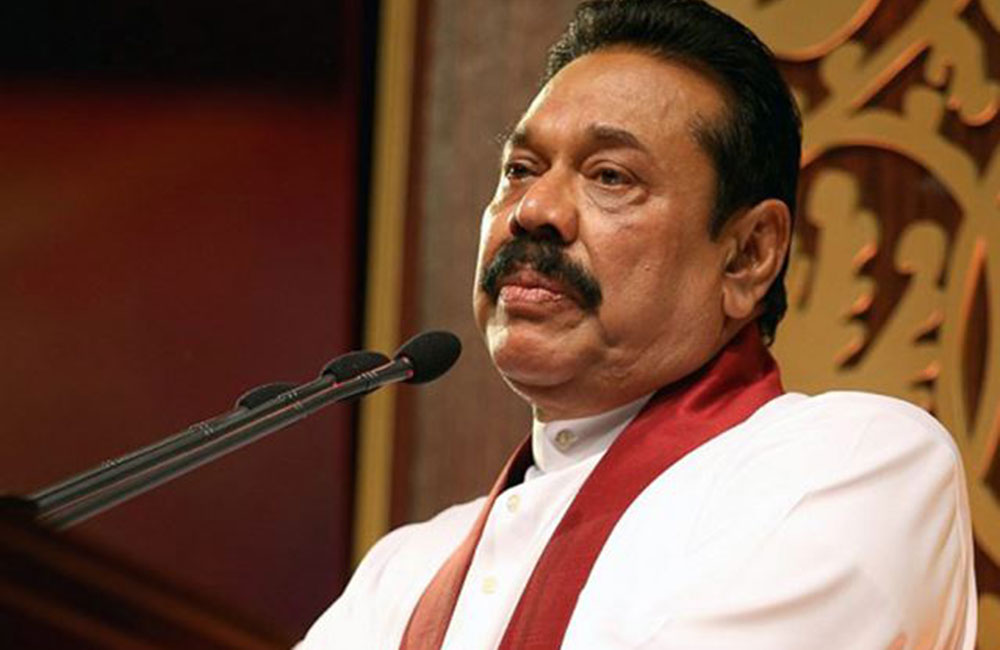
Messages from Rajapaksa’s New Delhi visit
N. Sathiya Moorthy
By visiting neighbouring India’s capital of New Delhi with politician-son Namal Rajapaksa and his SLPP party chief and ex-ministerial colleague G. L. Peiris, former President Mahinda Rajapaksa may have sought to send out a message of sorts, back home. The message was clear: India is no more an adversary. Nor possibly was India adversarial to his return to power, as Mahinda R. in particular had averred after his historic electoral defeat in January 2015.
In a way, the timing of the visit was as much crucial as it was not. ‘Crucial’ because, Sri Lanka for months now has been on election-mode.
The reference is to the presidential polls that are not due before January 2020 but about which speculation is rife in Colombo – motivated or otherwise.
‘Not-so-crucial’ because there is no knowing that a Rajapaksa, leave alone Mahinda R, can contest the presidential polls, for legal reasons of their own.
Yet, there is no denying the fact, and possible Indian perception, that the Rajapaksas may still hold the electoral key in their country, at least for the foreseeable future. It may not require a Rajapaksa to win the presidential polls. Instead, it may be enough for a candidate of their choosing to make their political adversaries to lose one.
Hidden horseIn Delhi, Mahinda met Prime Minister Narendra Modi, and also the Opposition Congress leadership of Sonia-Gandhi and son Rahul Gandhi. It may have also been an experience in early and direct diplomacy for Namal R, who has political ambitions for the future. If Namal’s ambitions cannot fructify early on, as Mahinda told media interviewers in the Indian capital, it also owes to the incumbent Government’s 19-A, whose main aim was to deny the Rajapaksas an early chance to return to power.
As is known, the 19th Amendment to the Constitution not only reversed the Mahinda era 18-A, which alone facilitated his contesting the presidential polls for a third term after having occupied the seat already twice. By upping the minimum qualifying age from 30 to 35, 19-A also denied Namal R an early entry into the presidential poll race.
With Gota R’s unwillingness to risk losing his American citizenship unless named SLPP-JO presidential candidate, the Rajapaksas may not have a personal run in the polls race just now. The other two qualified Rajapaksas in former Speaker Chamal and ex-Minister Basil, reportedly disinclined to take the plunge, the question remains if the ‘family’ has a ‘hidden horse’ that might offer its services in the cause of the nation.
Already, there is vague media speculation about the nation wanting a woman leader, after Chandrika Bandaranaike-Kumaratunga and her mother, Sirimavo, who was the world’s first woman Head of Government. If not from within the SLPP-JO, the UNP, according to some party leaders, should experiment, fielding a woman for the presidency. Maybe, more than the UNP, the SLPP-JO may take the message – and take it forward, too.
Extending courtesiesGiven that the SLPP-JO presidential candidacy is still in a flux, the Indian reception for the Rajapaksas may not have been as much as expected. If nothing else, the Indian media did not give Mahinda as much coverage as may have been wished for. But there was still a message in it, alright!
On the face of it, India has extended all courtesies to recognized Opposition Leaders and also former Heads of State and/or Government in the neighbourhood whenever they had expressed an interest to visit India – or, had an opportunity to do so. If they were to touch down at Capital Delhi, and if the dates did not clash, the Indian Prime Minister of the day had always found time to meet up with them. So have the main Opposition party leaders of the day – possibly in consultation with the authorities concerned.
From within Sri Lanka, present-day UNP Prime Minister Ranil Wicremesinghe used to be the subject of such Indian courtesies whenever he chose to visit Delhi. It was not a hidden fact that whenever pushed to the wall in the now-forgotten internal crisis within the UNP, when he was the Leader of the Opposition, Ranil W was believed to be taking the immediate escape route, by visiting Delhi, claiming that the ‘Government of India has called me for consultations’.
This time round, Mahinda R did not require such justification or excuses. Nor are there any problems within the party for him to face-off. His internal problems within the country come from outside of his own party, from the Government leadership of the day, to be precise.
Whether Court cases and the ‘surrender of passports’, say in the case of Gota R, for instance, could deny the Rajapaksas their popularity is a question that the Government leadership, both political and otherwise, should be asking itself. You do not call of marriages or weddings for want of a missing comb, or whatever!
Not the official hostTrue, the Government of India was not the official host of the Rajapaksas in Delhi this time. Nor was any State-run agencies/think-tanks come into the picture. Mahinda R was in Delhi to address a public Interaction organised by ruling BJP Parliamentarian and former Union Minister, Dr Subramanian Swamy.
As is known, Swamy continues to hate the LTTE and Prabakaran than he loves anyone in particular in Sri Lanka. As the only Sri Lankan political leader to stand up to the LTTE and Prabakaran, ram-rod straight and stood his ground under great international pressure, Mahinda has admirers in India. Swamy is the most vocal and visible of them!
Yet, by receiving Mahinda R, PM Modi has sent out a message to the present-day rulers, and possibly the divided Tamil leadership in Sri Lanka, it is for them to decipher the meanings. Definitely, India would want a strong and unwavering leadership in Colombo, which could stand at the vanguard of regional stability and security, where both nations have a lot to share. It should stop there.
If Mahinda claimed that Indian agencies had worked with their western counterparts to have him defeated, he did change his views without much delay. At the same time, if the present-day leadership of the Sri Lankan Government think that they have browbeaten India into helping to defeat Mahinda R in Elections-2015 playing up the ‘China card’, that again was a mirage of the past – even if true, for the sake of argument.
There are no permanent friends or enemies in international diplomacy, but only permanent (national) interests. India is no different in holding on to such perceptions. If nothing else, it would now seem, the present-day rulers have given away to China more than what even Mahinda as President did not imagine.
Mahinda seemed to believe that ‘development’ may be a substitute to ‘devolution’ for post-war Tamils and to ‘democracy’ otherwise. Against this, incumbent UNP Prime Minister Ranil, who actually seems to be in the driving-seat, portrays himself and the party as ‘liberal democrats’.
For PM Ranil in particular to manipulate the Hambantota equity-swap, as necessitated by an inherited ‘debt-trap’ and yet go in for more of Chinese loans of the kind, is just not on. One cannot run with the hare and hunt with the hound, and make the rest of the world believe that it is otherwise.
Less said about the Tamils and the TNA viz India, the better. By deliberately letting the ‘war crimes’ probe to be taken to the UNHRC, they helped ensure that it was out of India’s reach.
Now they too cannot complain that India was ‘not doing enough’. Worse still, their new-found, or re-discovered western friends, too are realising that they did not know Sri Lanka enough, to have meddled in there, out of growing apprehensions for China – or, so it would seem!
This commentary originally appeared in Ceylon Today. A double-graduate in Physics and Law, and with a journalism background, N. Sathiya Moorthy is at present Senior Fellow & Director of the Chennai Chapter of the Observer Research Foundation.
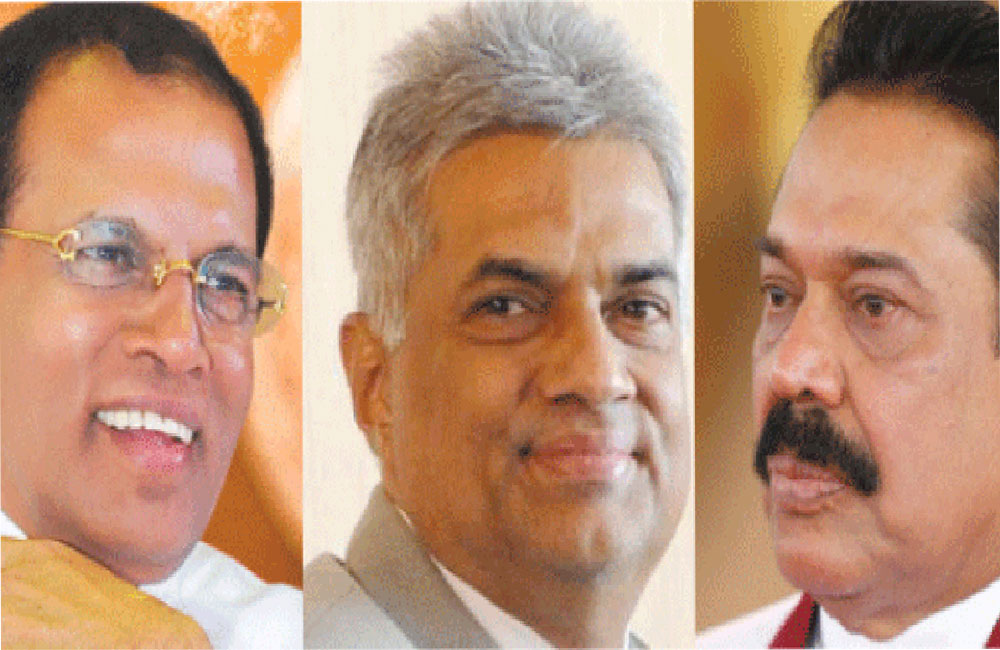
Moody’s downgrade of SL sovereign debt: A pat for Central Bank, while slapping the President
By W.A. Wijewardena
Sacking of a Government and harvesting a credit downgrade
Moody’s Investors Service, in a recent ratings change, downgraded Sri Lanka’s sovereign debt from B1 to B2, while improving the country’s economic Outlook from Negative to Stable (available at: https://www.moodys.com/research/Moodys-downgrades-Sri-Lankas-ratings-to-B2-changes-outlook-to--PR_391459).
Its prompt move to revise Sri Lanka’s rating status is understandable, since rating agencies had been blamed for not warning the investors in time before Greece bonds became worthless in 2009. The other two rating agencies, Standards and Poor’s and Fitch Ratings, are yet to come up with their own analysis of the country’s changed debt profile after President Maithripala Sirisena on 26 October summarily sacked his three-year-long companion in power, Prime Minister Ranil Wickremesinghe, and appointed his arch enemy, the former President Mahinda Rajapaksa, in his place.
The economic fallout of this rash action was analysed by me in a previous article in this series in which I argued that the economy was to be the casualty unless the man-made constitutional crisis was resolved quickly (available at: http://www.ft.lk/columns/With-this-man-made-Constitutional-crisis--economy-will-be-the--casualty--resolve-it-quickly-or-peris/4-665587?fbclid=IwAR1ZYCCvHo-pFqp3rqWnTze5vH0yOBhnegtXNtnHptETk6xYPzKJG99Rf48). Yet, the crisis lingered on moving from bad to worse in each passing day without any sign of a sound resolution in sight.
This made investors in Sri Lanka’s sovereign debt nervous and anxious. For instance, the Sri Lanka government sovereign bonds that are to mature in January and April 2019 witnessed a rate jump from around 5.5-5.8% to around 9-10.8% within a week. This is quite contrary to the behaviour of bonds which have a tendency for market prices to converge to face values when the maturity date comes closer. What it implied was that the holders of these bonds have attempted to quit them by dumping them in the market wholesale. Hence, Moody’s has fulfilled its obligation to investors by coming up with a revision in rating and faulting the rating agency for doing so may not be in order.
Two components of rating results
The rating results pertaining to a sovereign borrower have two components. One is an ‘alpha-numerical value’ it assigns to a country indicating the probability of a sovereign borrower defaulting a particular borrowing. The other is the subjective assessment about the short to medium term outlook of the economy, whether it is healthy, stable or unhealthy.
An alpha-numerical value to denote the probability of credit default
In the case of Moody’s, the alpha-numerical values with low default risk have ranged from Aaa denoting the best to Baa3 denoting passable. These are known as investment or prime grade borrowings. Those assigned from Ba1 to C carry a high default risk and are normally known in the market as speculative or non-investment grade borrowings. In the market terminology, these bonds are derisively known as ‘junk bonds’ or simply ‘junkies’.
Since the profit is the degree of risk which an investor would take, there is a demand for these junkies too. The only difference is that the investors will expect a higher profit or yield to compensate for the higher risk they are taking. This additional profit they are expecting is called the ‘risk-premium’ and it changes from 4% at best to even 10% at worst.
Sri Lanka had been rated at B1 earlier by Moody’s or its equivalent at B+ by Standards and Poor’s and Fitch Rating. This was four notches below the investment grade borrowings and, hence, were categorised as junkies. Since the risks were high, the risk premium which investors put on Sri Lanka was about 4-4.5% over the rate which a best borrower at Aaa would have got. With the downgrading from B1 to B2, this risk premium will jump at least by about half a per cent or in market terminology by about 50 basis points.
Since the risk premium in the case of bonds to mature in 2019 has already jumped to about 8%, the risk is that Sri Lanka would not be able to issue sovereign bonds in the market for less than 10% immediately. That is why a Sri Lankan Government official in a recent press briefing had opined that it was not time for the country to go to the international sovereign debt market immediately and would look for funding from elsewhere (available at: http://www.ft.lk/front-page/Govt--opts-for-local-options-as-Moody-s-downgrade-ups-pressure-on-intl--borrowing-costs/44-667402).
Subjective assessment of economic outlook
The second component of a debt rating, the country’s economic outlook, is a subjective assessment of the state of the economy based on what the assessor has read about its plans, developments and actual achievements. This subjective assessment can be one of the three positions, Positive, Stable or Negative.
This can be compared with the opinion expressed by a physician on a patient based on the latter’s reaction to the medication administered to him. If the physician opines that the condition of the patient is negative, his health conditions are fast deteriorating, he does not answer to medication and he needs to have special care in an intensive care unit for otherwise it is not possible to save his life. It is a hopeless case. If the condition is stable, he has improved a lot, can be transferred from the Intensive Care Unit to the ward and will, with good medication, have the chance of recovering fully. If it is positive, he has recovered, answered well to medication and could be discharged from the hospital with only follow-up wellness treatments.
In the case of an economy, changing from Negative to Stable means that the economic patient of Sri Lanka has answered to past medication and could recover completely provided proper curative treatments are administered to him. It is out of danger and could be transferred to the ward for normal treatments. It is indeed a good sign for Sri Lanka’s ailing economy.
Moody’s has justified the upgrade as follows: ‘Over the medium term, planned changes to Sri Lanka’s Monetary Law Act should help the Central Bank anchor inflation expectations and ensure monetary policy independence from fiscal developments. A shift toward market-oriented policy frameworks – including inflation-targeting and floating exchange rate policies – could increase the effectiveness of Sri Lanka’s monetary policy by helping to stabilise the cost of debt at lower levels than in the past and bolster fiscal flexibility’. Thus, the Central Bank should not take offence since it is a pat on its back.
Subjective assessment is based on evidence
In the past 10 year period since Sri Lanka was subject to international credit rating, the country had never been in the Positive category. It had hovered between Stable and Negative positions, moving from one to the other quite frequently.
As I mentioned earlier, this is a subjective assessment based on evidence. The evidence is gathered by rating agencies from a variety of sources, namely, plans of the country, published and unpublished data, interviews with public officials, political leaders, officials in international agencies like IMF, World Bank, ADB or UN System and private sector think tanks and thought leaders. All the evidence gathered is screened, assessed and synthesised to form a single opinion on the country: whether the economy shows good signs, remain at an acceptable level or has moved into worse conditions.
Once again, if this subjective assessment is not to the liking of the authorities, all they can do is to change the behaviour so that those who provide information on the country will paint a favourable picture about the prevailing economic status. Fighting a war with the rating agency on that count will prove unproductive.
The man-made political crisis is the culprit
Moody’s has reasoned out the downgrading from B1 to B2 as follows: ‘The decision to downgrade the rating to B2 is driven by Moody’s view that ongoing tightening in external and domestic financing conditions and low reserve adequacy, exacerbated most recently by a political crisis which seems likely to have a lasting impact on policy even if ostensibly resolved quickly, have heightened refinancing risks beyond levels anticipated when the rating agency affirmed the rating at B1 with a Negative outlook in July. Moody’s projections include a slower pace of fiscal consolidation than assumed in July to reflect disruption to fiscal policy implementation in a period of political turmoil.’
The crisis will have a lasting impact on the economy
The main culprit has been the political crisis which has worsened the country’s ability to raise new funds to meet its prevailing debt servicing obligations. This crisis is the handiwork of the President, as many analysts had pointed out, by taking a hasty decision to fire a government based on his personal vendetta against its Head and appointing a government which does not command majority in Parliament.
The inability of the government appointed by the President to show its majority in Parliament has been demonstrated by a score of defeats it has suffered in the House in the last 10-day period: two no-confidence motions, one policy statement and a further one involving the composition of the Selection Committee in Parliament. As the world saw it, the members of the President’s government had resorted to unruly behaviour within the House, walked out of it without facing a vote and resolved themselves to the tactic of briefing the media on what they were planning to do to gain power in Parliament.
Moody’s feels that even if this crisis is resolved by using ‘ostensible’ tactics, it will have lasting impact on the country’s decision making processes. In other words, in the opinion of Moody’s, the country’s ability to get out of the present economic crisis is not within sight due to the man-made political crisis.
Credit downgrade is a slap for the President
Moody’s has also noted that the prevailing political crisis has weakened Sri Lanka’s ability to implement a full-scale economic reform program which it had promised the IMF when the country sought its assistance in 2016 under an Extended Fund Facility or EFF.
Says Moody’s: ‘A steady and credible implementation of planned fiscal and economic reforms would improve Sri Lanka’s ability to sustain investor confidence through the upcoming period of large debt maturities. However, the likelihood of the government pursuing its reform agenda on the previously planned schedule has fallen following recent political events that have interrupted the reform momentum. Moody’s does not expect the current political crisis to be fully resolved rapidly, and the crisis is in any event likely to leave its mark on the pace and content of the reform program. Even if past episodes of political disruption have not changed the broad direction of reforms in Sri Lanka, delays in the pace of reform will at a minimum limit the government’s ability to respond to changing market conditions.’
The important reading here is that the current political crisis will not be resolved quickly and even if it is resolved, it would affect both the speed and the coverage of the reform program. In other words, they would be too slow as well as too short. Hence, the downgrade of the country’s credit rating from B1 to B2 is a slap for the President.
Cause of downgrade has been the worsened ‘eyeball fundamentals’
The Central Bank, as usual, has issued a protest statement against the downgrade (available at: https://www.cbsl.gov.lk/en/node/4499). The bank has argued that the downgrade has not done justice to the improved macroeconomic fundamentals of the country in the recent past. In fact, as I have presented above, the cause of the downgrade has not been any worsened macroeconomic fundamentals.
Indeed, they have improved slightly with promise to deliver better results in the near to medium term. Inflation has been subdued, exchange rate corrected to reflect better market conditions and the budget on a pre-planned consolidation path. The cause of the downgrade has been the worsened ‘eyeball fundamentals’ as demonstrated by the lingering political crisis with no resolution in sight and a government totally non-functioning due to lack of majority in Parliament. These are visible fundamentals to concerned Sri Lankans as well as foreign investors.
No budget for 2019, no expenditure as well
For example, take the case of the government’s expenditure and revenue programs for 2019. With the prorogation of Parliament and due to the riotous behaviour of parliamentarians, there is no possibility for presenting a budget now in Parliament and get it approved before the end of 2018. Even if a temporary vote on account is presented by the Rajapaksa group, it is unlikely that it will get the sanction of the legislators.
Unless the government spends money, tax people and borrow funds by violating the Constitution, the government services will come to a standstill in 2019. That is because without a budget, it will have no powers to spend money, raise new taxes or borrow money to meet any gap in the revenue. The repayment of debt is also at risk, though some have argued that the governing debt legislations have empowered the Deputy Secretary to Treasury to charge it to the Consolidated Fund, a fictitious account that does not exist in reality.
The fictitious Consolidated Fund
As I have argued in a previous article (available at: http://www.ft.lk/opinion/The-flash-election--A-political-way-out-or-an-instance-of-one-mistake-leading-to-another-/14-666609?fbclid=IwAR1C5zAZkYcuVBDeNXlB5AYdZxzNDNm5rOG55c_0Y8WvcwAQrouHOE4jS8E), the Consolidated Fund which is always overdrawn is simply a summary of the cash-flow of the Treasury and if there are no adequate credits to that cash-flow, no debits can also be made to it. To repay foreign debt, for example, the government has to buy foreign exchange from the Central Bank which has enough of it now by delivering rupee funds.
In the past, if rupee funds are not available, the Central Bank made a temporary arrangement by supplying the same by issuing a Treasury bill to itself. Without Parliamentary sanctions, this also cannot be done in 2019. In the past, the government was a beneficiary of the provisional advances given to it by the Central Bank up to 10% of the estimated revenue of the government for the forthcoming year. Since that revenue was always bigger than the previous year’s revenue, there was always a net gain for the government by way of fresh money.
Without a budget for 2019, this source is also closed for the government. Hence, there is the overdrawn Consolidated Fund and debiting it to generate rupee funds to buy foreign exchange is a farcical exercise. These are the hard ‘eyeball fundamentals’ which Moody’s has used to downgrade the country’s credit rating. Hence, instead of finding fault with Moody’s, a solution has to be sought to overcome the present budgetary impasse.
The way to resolve the crisis is for the President to keep a step backward, go back to pre-26 October state after the withdrawal of the support to Wickremesinghe Government by UPFA but before swearing in of Rajapaksa as the premier and allow Parliament to select a government which can present for the time being a vote on account to cover expenses at least for the first three months of 2019.
A pat for the Central Bank for good achievements
Meanwhile, the Central Bank should be happy because the decision to upgrade the country’s economic outlook from Negative to Stable has been due to the positive action taken by the bank to bring about a better set of macroeconomic fundamentals.
Moody’s has justified the upgrade as follows: ‘Over the medium term, planned changes to Sri Lanka’s Monetary Law Act should help the Central Bank anchor inflation expectations and ensure monetary policy independence from fiscal developments. A shift toward market-oriented policy frameworks – including inflation-targeting and floating exchange rate policies – could increase the effectiveness of Sri Lanka’s monetary policy by helping to stabilise the cost of debt at lower levels than in the past and bolster fiscal flexibility’. Thus, the Central Bank should not take offence since it is a pat on its back.
To resolve crisis, go back to pre-26 October state
The way to resolve the crisis, as I have suggested in my previous articles, is for the President to keep a step backward, go back to pre-26 October state after the withdrawal of the support to Wickremesinghe Government by UPFA but before swearing in of Rajapaksa as the premier and allow Parliament to select a government which can present for the time being a vote on account to cover expenses at least for the first three months of 2019.
W.A. Wijewardena was a former Deputy Governor of the Central Bank of Sri Lanka. He can be reached at This email address is being protected from spambots. You need JavaScript enabled to view it.. (Via Daily FT)y
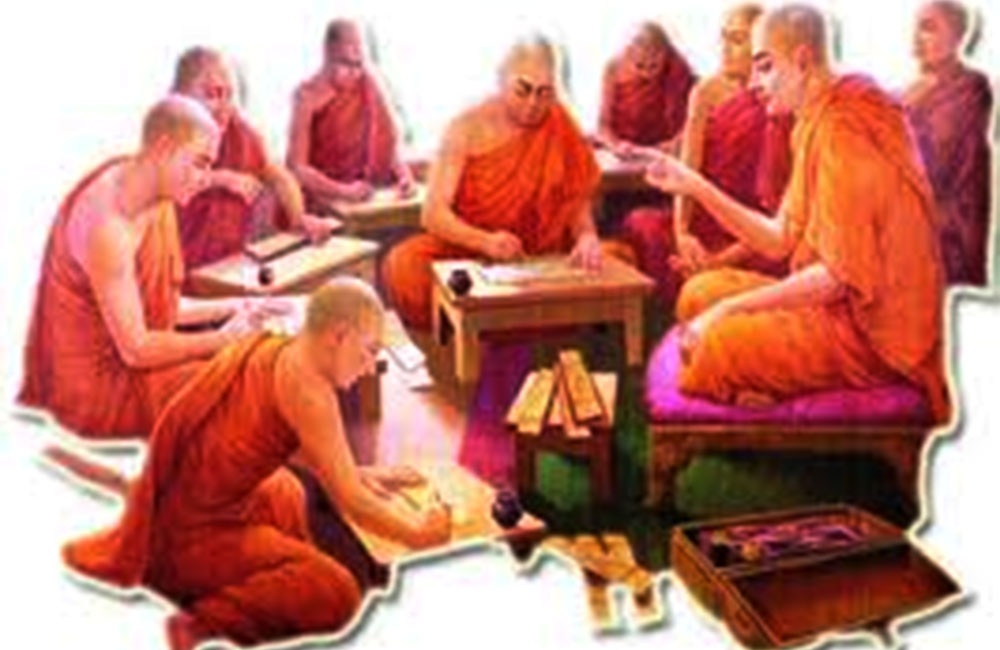
Buddhist extremism: is monk Gnanasara’s jailing a sign of Sri Lankan enlightenment?
Just before being hauled off to jail, the seemingly untouchable firebrand monk – clad in a brilliant saffron robe – wanted to get in the last word.
“I have done my duty towards the country,” Galagoda Aththe Gnanasara told reporters early this month as he boarded a prison transport vehicle shortly after his sentencing in a Colombo courtroom. “Why should I regret?”
While the controversial monk expressed no remorse, his many critics were cautiously hopeful that his internment showed Buddhist extremists were no longer untouchable in a country where hatred is easily sparked in the tinder dry jungle that is Sri Lanka’s combustible religious make-up.
Controversial Buddhist monk Galagoda Aththe Gnanasara Thero/AFP
The monk Gnanasara, head of the so-called Buddhist Power Force, was sentenced to six-months in jail for threatening the wife of a missing journalist, a surprise decision in a country where Buddhist extremists are not often brought to justice.
“That government prosecutors supported a custodial sentence is also positive and noteworthy, as Sri Lankan governments have been reluctant to prosecute militant monks, even when there has been strong evidence of their involvement in crimes,” said Said Alan Keenan, a Sri Lankan specialist at the Project Crisis Group in London.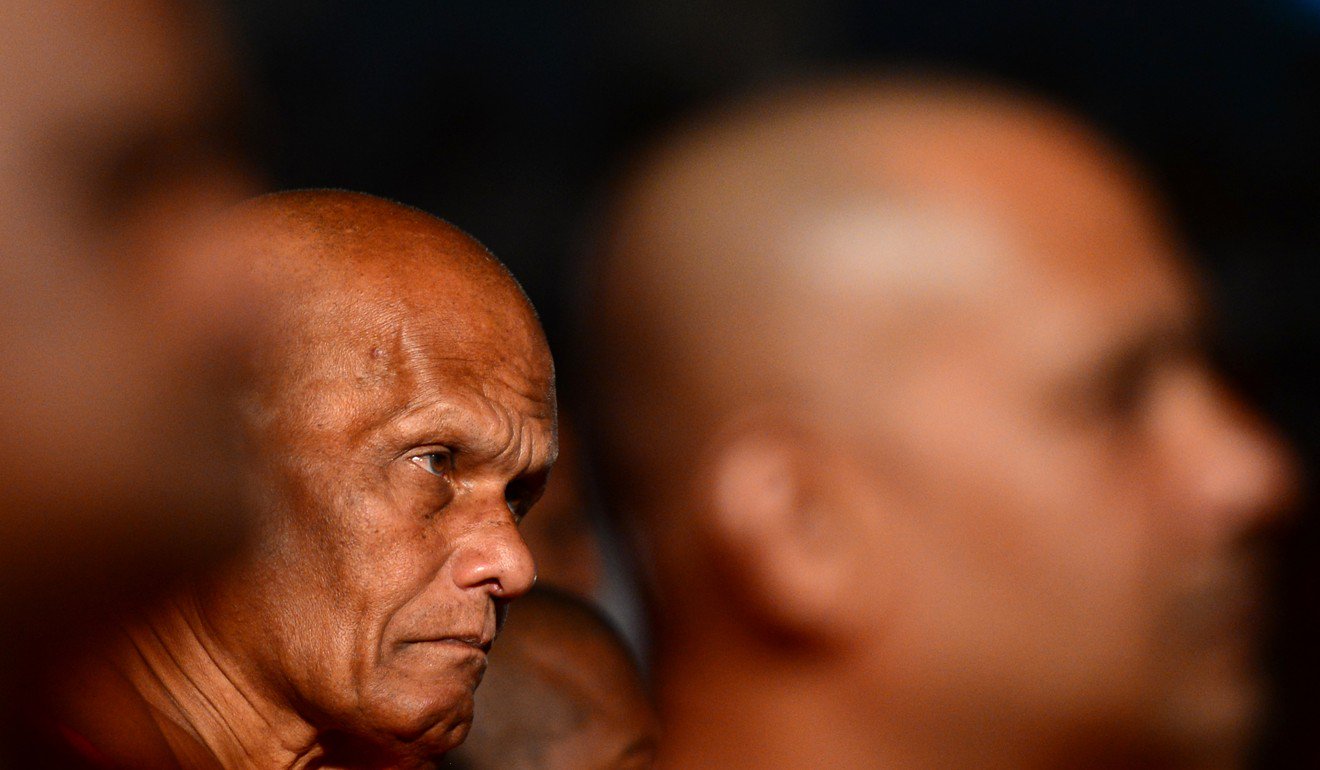
Buddhist monks at a Bodu Bala Sena or Buddhist Power Force convention in Colombo/AFP
In this case the monk was not convicted of a crime involving inciting religious violence, an accusation that has dogged him and his organisation, known locally as the Bodu Bala Sena, or BBS, for years. The monk was instead brought down by the acrimonious hangover from the civil war that ended in 2009.
Some believe the conviction of the monk reaffirms the independence of the judiciary, which comes just months after Sinhalese mobs, urged on by Buddhist monks, attacked mosques and shops owned by Muslims in the central city of Kandy. An island-wide state of emergency was imposed, and restrictions were slapped on Facebook and other social media to cap the violence. Monk Gnanasara was accused of whipping up anti-Muslim sentiment when he attended the funeral of a Sinhalese truck driver who died after being attacked by a group of Muslim men in a road rage incident.
Muslims make up only 10 per cent of the country’s population and historically the biggest ethnic fault line has been between the Sinhalese Buddhists, with 70 per cent majority, and Tamils, who are often Hindu, which constitute around 13 per cent of the population.
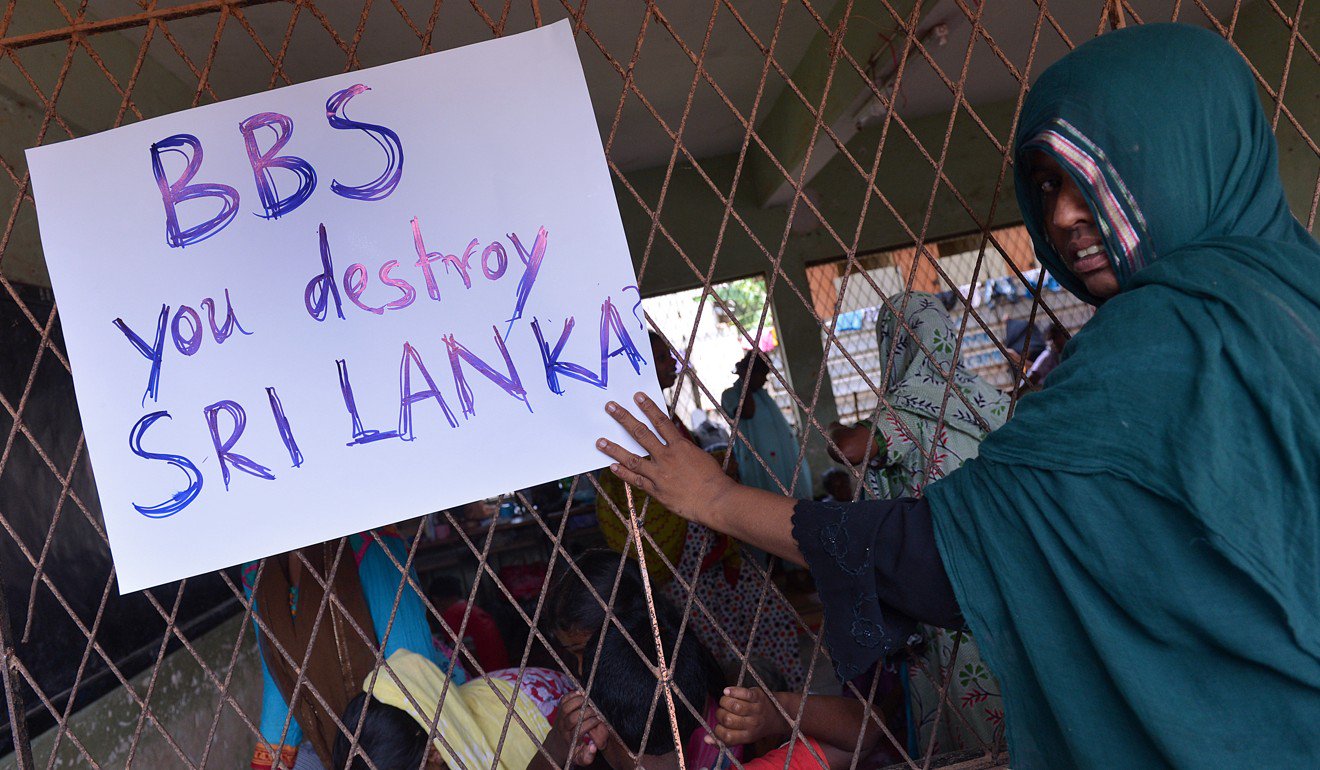
Muslims, made homeless after two days of anti-Muslim riots in Sri Lanka’s tourist region of Alutgama, demonstrate against radical Buddhist group Bodu Bala Sena/AFP
The Sri Lankan army, after a brutal war lasting more than a quarter of a century, crushed the Liberation Tigers of Tamil Eelam in 2009 who were fighting for an independent Tamil homeland in the north.
President Mahinda Rajapaksa’s government of the day was often accused of stoking a sense of triumphalism after the war, which encouraged the rise of militant Sinhalese Buddhist nationalism. But in 2015, President Maithripala Sirisena took power on promises to reinforce the judiciary, fight corruption and investigate war crimes, sparking hopes of reconciliation among the ethnic factions.
A prominent newspaper columnist, Tisaranee Gunasekara, said the case of Monk Gnanasara “reveals the degree of progress made since January 2015 as well as its limitations”.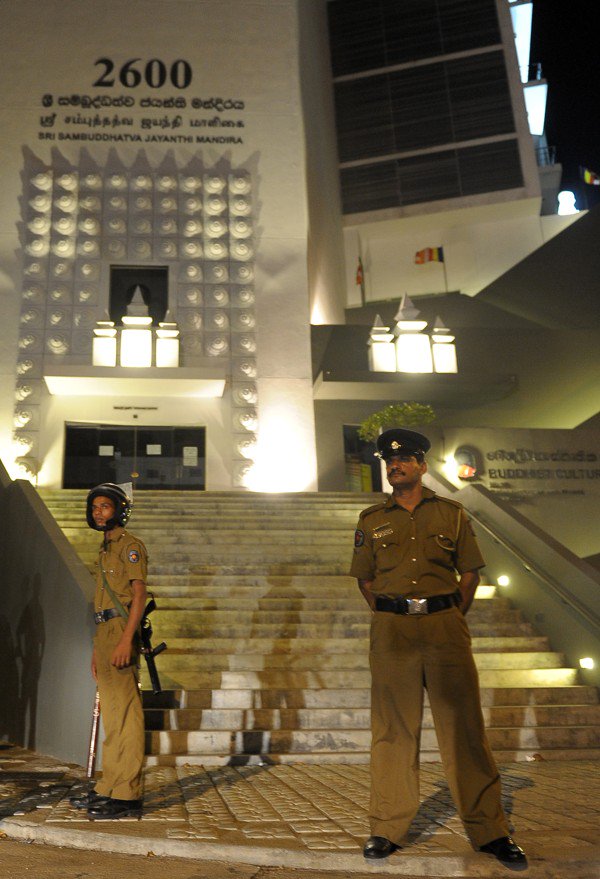
Sri Lankan police guard the headquarters of the Bodu Bala Sena after dispersing activists demonstrating against religious extremism and hate speeches/AFP
She noted in a column in the Sri Lankan Guardian that the monk was not being held responsible for the March riots, nor for an incendiary speech in 2014 that critics blamed for inciting Sinhalese Buddhists to attack Muslims and their property in southwestern parts of the country, leaving at least four dead and 80 injured.
“Though elected to challenge extremism of every variety, the government’s preferred policy is a cross between appeasement and acting the ostrich,” the columnist Gunasekara wrote of the current government.
Keenan at the Project Crisis Group said Gnanasara and other radical monks faced a variety of charges involving hate speech, intimidation and incitement to violence against Muslims.
“But the cases have made little progress and there is no sign the government is willing to prosecute,” said Keenan. “As long as it hesitates to tackle the problem, the risks of more and possibly more serious violence will remain.
Russell Blinch/SCMP
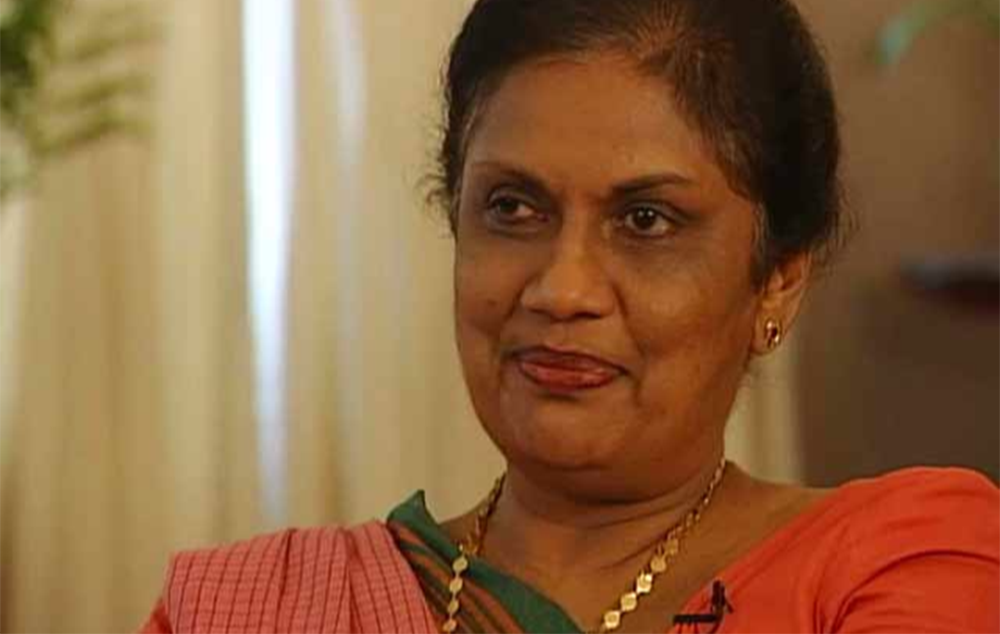
Enduring Legacy of Former Sri Lankan President Chandrika Bandaranaike Kumaratunga
By Srimal Fernando and Pooja Singh
A long and difficult election journey for uncountable numbers of Sri Lankan politicians and for party supporters of Sri Lanka Freedom party (SLFP) had proceeded in June 1994. That year was a turning point in Sri Lanka’s politics as well as for the SLFP led by Chandrika Bandaranaike Kumaratunga (CBK) the daughter of two Sri Lankan Prime Ministers. Chandrika won the presidential elections by 62.28 percent and where the People’s Alliance (PA), a coalition with SLFP won electorates winning the race in 159 constituencies out of the 160. Immediately, after her swearing in as President, Chandrika seized the initiative and formed a coalition government with leftist parties led by the People’s Alliance (PA). She thus became the Chairperson of the SLFP. Concerns about Sri Lanka’s international legitimacy played an integral role in Chandrika’s policy priorities as soon she became President. At that time, the ethnic conflict and socio-economic well-being of the Sri Lankan multi-cultural society were the fundamental underlying questions the country was facing. Former Sri Lankan President was always grateful for any ideas to solve the ethnic problem no matter where the suggestion came from. Given these features and trends, former Sri Lankan President immediately aspired to solidify the Sri Lankan Foreign Policy. In this context, the Bandaranaike – Nehru and Gandhi relations has been one of the main features in Indo – Lanka relations for the past seventy years.
In all of this, President Chandrika appeared to have reflected both perspectives of the rural masses in which she had lived during much of her time in the Island nation and Bandaranaike’s family legacy which she had grown up. In Sri Lanka, within the political traditions, the cultural values of majoritarianism are embedded deeply especially within the Sinhalese society. At the same time, Chandrika was aware about the high level of popular political situation about the national question among the Sri Lankan voters. Chandrika persuaded mainly the Sinhalese voters to go for a peaceful settlement with the Tamil community mainly living in the North and Eastern provinces. Her government held several rounds of peace talks with the Liberation Tigers of Tamil Eelam (LTTE) also known as Tamil Tigers which lasted for a short time.
The Sri Lankan government feared about stumbling into a full scale confrontation after the fragile peace talks collapsed. In 1995, Sri Lankan forces captured the strategically important Jaffna Peninsula. Hence, this topic among Sri Lankan politicians were bitterly debated. Despite the enormous challenges, Former President Kumaratunga took on her two term Presidency and gracefully transferred her presidential powers to the next leader. Even today, this democratic transition of presidency is still considered an overwhelming success for Sri Lanka. However, her Presidency has been slow to respond to new realities due to various reasons.
During the December 1999 presidential election, an unanticipated event played a critical role for the first time since 1994 with a bomb blast and assassination attempt on the former president by the Tamil Tigers. The Presidential election process was severally damaged in the final stages of People’s Alliance (PA) election campaign even before a new President was sworn in. Few days later, amidst emotional support Chandrika won the second term. The issue of the ethnic conflict in Sri Lanka above all topped the list of voter’s concerns. Nevertheless, the major efforts of Chandrika to solve the ethnic problem encountered immovable opposition mainly from UNP. The Parliament’s reaction to the peaceful settlement towards the ethnic question split along predicable ethno geographic and party lines especially with SLFP and UNP Parliamentarians.
When Mangala Moonesinghe chaired a parliamentary Select Committee on the ethnic conflict, the proposal to solve the national problem was rejected mainly by the opposition, the United National Party (UNP). The UNP’s rhetoric strategy to solve the national question was a fiasco at that time. In addition, Chandrika’s government was having difficulties in bringing a peaceful solution to the country’s security situation due to constant attacks by the Liberation Tigers of Tamil Eelam (LTTE). In 2001, former president’s popularity continued to sour. The UNP leadership under Premier Ranil Wickramsinghe came into power in 2001. President Kumaratunga could not escape the association with the new Prime Minister Wickramsinghe’s UNP government from 2001 to 2003. For the first time in Sri Lanka’s Parliamentary history, sharing power between two opposing parties was therefore an unfamiliar experience. During this period, a Ceasefire Agreement (CFA) was signed between the government of Sri Lanka and the LTTE with the facilitation of the Norwegians. Three years later, a realignment with PA- Janatha Vimukthi Peramuna (JVP) formed the United People’s Freedom Alliance (UPFA) in 2004. In the general election of April 2004, the former president’s party regained power and Mahinda Rajapaksha was appointed as Prime Minister. Despite the enormous challenges during Chandrika Kumaratunga’s presidency was still considered an overwhelming democratic success.
Over the years, these strong linkages have proved most enduring and have taken several forms. Under the leadership of president Kumaratunga after signing the South Asian Free Trade Area (SAFTA) and Indo-Sri Lanka Free Trade Agreement (ISFTA) set the stage for Sri Lanka to increase the bilateral trade figures to US$ 5.2 billion in the coming decades. It seems probably that Sri Lanka under the leadership of Chandrika Bandaranaike Kumaratunga prepared the ground for stable Indo-Sri Lanka relations and a conducive environment for a possible trading bloc. Hence, one could argue that her presidency represents Bandaranaike and Gandhi’s legacy. In late years of her presidential era the SLFP’s interparty unity was weakened. Her immediate successor was Mahinda Rajapaksha.
Looking back at her path to presidency was not very easy. In 1959, Premier S.W.R.D. Bandaranaike, the father of Chandrika Bandaranaike Kumaratunga was assassinated by Talduwe Somarma Thero, a Buddhist monk. This attempt on her father reinforced the socialist democratic forces to bring her mother, Sirimavo Bandaranaike into politics. She was a close family friend of the then Indian Prime Minister Nehru and Indira Gandhi. After the defeat of Sirimavo Bandaranaike and SLFP in 1978, the party returned to power in 1994 after a gap of seventeen years. Unfortunately, history repeats itself after the assassination of S.W.R.D. Bandaranaike in 1988, her film star husband Vijaya Kumaranatunga was assassinated by the Marxist rebels. This day was called as the black Thursday in Sri Lanka’s political history. On the day of the Vijay Kumaratunga’s funeral, over 200,000 people came to express their grief in solidarity with Kumaratunga’s legacy. The emotional situation catapulted her to be a suitable alternative political leader and a force to break the deadlock of UNP’s autocratic rule. Mrs. Kumaratunga’s road to greater prominence in Sri Lanka’s politics began as the Chief Minister of Western Provincial council.
The decisions of yesterday Chandrika Bandaranaike Kumaratunga took or implemented during her presidency from 1995 to 2005 are only the starting points of Sri Lanka getting adjusted to a new trend in executive presidency to unite the nation under a democratic system. If one is to analyze these three Presidents SLFP had produced so far, Chandrika Kumaratunga was one of the most pragmatic political visionaries who was able to influence Sri Lanka’s democratic transition foreign policy and uplift the well-being of the rural masses in the South Asian island nation.
In the general election of August 2015, this relatively stable party system changed dramatically and new trend in parties arose. One of the major consequences of the fragmented party system in Sri Lanka and declining UNP-SLFP main stream national party hegemony has been the growing concerns to produce stable governance system within a democratic system for the island nation. Today, there is further subdivision with the main national level parties. The consequence was that the relatively stable UNP, SLFP, the Tamil National Alliance (TNA) party model gave away to new parties like SLPP led by Mahinda Rajapaksa and the Tamil People’s Alliance (TPA), a break-away of TNA led by C.V. Vigneswaran. For example, Sri Lanka Podujana Peramuna, a break-away of SLFP party policies overlaps considerably with Sri Lanka Podujana Peramuna (SLPP) mandate. However, over the years due to these divisions there has been contrasting views from certain section of the SLFP members about Chandrika’s leadership.
Hence, it is a time for discussion and consultation among the SLFPs and the followers of the Bandaranaike’s party doctrine. The SLFP must produce simple solutions to simple problems that is affecting the stability of Sri Lanka. Chandrika Bandaranaike tenure as president of Sri Lanka distinguished above all by her foreign Policy and also attempting to reconcile with all communities living in South Asian island nation.
*This was first published on moderndiplomacy.eu
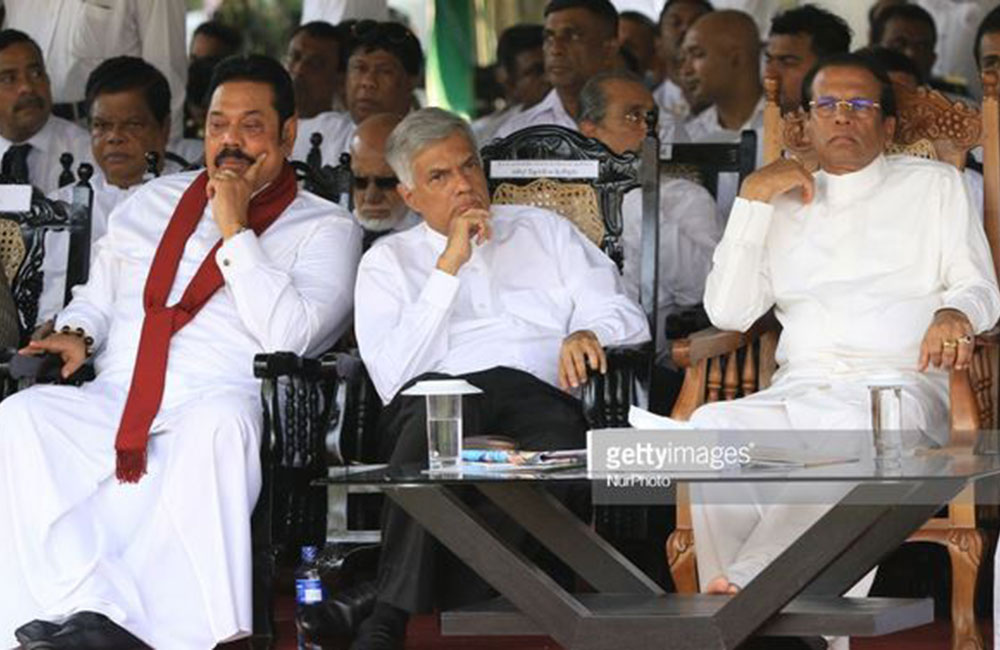
Some Thoughts On Sri Lanka’s Upcoming Presidential Election
By Dr. S. I. Keethaponcalan
Attending the late Maduluwawe Sobith Thera’s 76th birth anniversary at the Sri Lanka Foundation Institute, President Sirisena warned the country not to think too much about the upcoming presidential election in 2020. According to the Sunday Times (June 03, 2018) the president has claimed that “there is lots of talk about presidential candidates. That is a crime as the elections are due only at the end of next year. Already presidential candidates are being named. This will lead to instability in the country. By creating an election interest, one and a half years before the elections, the state officials will stop their work.” It is true that when changes are expected after major elections, attitude of the public-sector employees also change. This is an unavoidable side-effect of national elections in Sri Lanka. Did Sirisena unconsciously admit that he has no chance of winning the presidential election in 2020? This is an interesting question, but it is not the focus of this essay.
There has been a degree of hypocrisy in the appeal that it is too early to think about the impending big election. When President Sirisena asked the Supreme Court whether he can serve as president for six years instead of the five-year period stipulated by the 19th Amendment, he was thinking about the election. Unfortunately for Sirisena, the Supreme Court said no. Moreover, almost all major parties have started contemplating and some have already started preparing for the presidential election. Hence, it is not completely inappropriate to think about the election on our part, the ones who will be at the receiving end of any outcome of the election.
A couple of weeks back, the Janatha Vimukthi Peramuna (JVP) presented its proposal for the 20th Amendment to the constitution. The proposal seeks to transform the existing executive presidential system into a cabinet form of government. It seems that the JVP is the only party that sincerely believes in abolishing the executive presidential system. All others who support the idea, seem not too serious about the change. They like it. Obviously, as a small party, the JVP can play a major role in governance under a cabinet system. Hence, the persistence of the JVP on this issue has not been a surprise.
Nonetheless, I expected the Joint Opposition or the Sri Lanka Pudujana Peramuna (SLPP) to support the JVP proposal. Under the existing constitutional arrangements, Mahinda Rajapaksa cannot come back to power as president. The 19th Amendment reintroduced the two-term limit. Hence, under a Westminster model of government, Rajapaksa would have no problem winning the general election and come back to power as prime minister. The abolition of the executive presidential system will resolve Rajapaksa’s two term problem. The party however decided not to support the JVP proposal. What does the decision suggest about the SLPP’s strategic calculations?
For me, it indicates that the party has been extremely confident about the likelyhood of winning the upcoming presidential election. The confidence most likely stems from the recent local government election results. The SLPP secured about 45 percent of the votes in this election. Will the same votes be recast for the SLPP candidate in the presidential election? Most likely, yes.
One, bulk of the SLPP votes in the local government election came from the Sinhala heartland, which consistently votes for Rajapaksa. Even in the 2015 presidential election, votes in the Sinhala heartland went to Rajapaksa; not Sirisena. Two, one of the main reasons which stirred a lot of dissatisfaction towards the ruling coalition in this election was the high (or in the words of some people, unmanageable) cost of living. Postelection, the government has hardly done anything to lower cost of living. Instead, as far as I know, cost of living has been increasing steadily. Hence, there is no evidence to suggest that Sinhala votes could be redirected towards the UNP or the SLFP in the near future.If this is the case, the SLPP needs only about six percent more votes to win the presidential election. This six percent could come from two sources: (1) about 14 percent votes the SLFP/UPFA gained in the local elections or the Muslim votes. In order to tap into the SLFP/UPFA votes, the SLPP needs to either appease and start collaborating with Sirisena or undertake a concerted scheme to prevent him from contesting the presidential election.
Given the animosity between the Rajapaksa faction and Sirisena, incorporating the president into the SLPP headed coalition seems unlikely. If the SLPP succeeds in convincing Sirisena not to contest, the party candidate will most probably win the election.
Another promising source is the Muslim votes. Antagonizing the Muslims through the actions of Bodu Bala Sena and other militant Buddhist entities negatively affected the Rajapaksa coalition in the last election. There have already been moves to entice the Muslims. For example, Gotabhaya Rajapaksa, the presumed SLPP candidate, recently stated that “Muslims are ready to work hand-in-hand with the Rajapaksas to form a government under the leadership of former president Mahinda Rajapaksa.” (Daily Mirror, May 29, 2018). He has already been attending Muslim religious ceremonies. Can the Muslims be convinced to vote again for Rajapaksas? Of course. The continuing attacks on the Muslims during the tenure of the unity government may influence at least a segment of the Muslim voters to support one of the Rajapaksas in this election. Hence, the prospect of the SLPP candidate in the presidential election looks very bright.
Only problem I sense in the candidacy of Gotabhaya Rajapaksa, who has been promoted as the SLPP candidate by interest groups, is the possibility of mobilization by large segment of the minorities and pro-democracy forces against Gotabhaya. His candidacy has the potential to ignite a protest vote against the SLPP in this election. Another Rajapaksa, for example, Basil may not invoke the same degree of resistance. One has to wait and see how the SLPP thinking evolves on this issue.
The split between the Sirisena faction and the UNP seems well-defined now. Parties are exchanging barbs against each other vigorously. The split means the UNP will not repeat the same strategy in the 2020 election and support Sirisena. This on the other hand means that the UNP will field its own candidate and Sirisena will not be able to secure a second term. In the local government election, the UNP gained 32.61 percent of the votes. Reaching the 50 percent mark will be an uphill task. The problems of the UNP will be compounded by the fact that the party does not have any more space to expand its presidential vote, except the Tamil votes.
Going by the recent attitude of the Tamil National Alliance (TNA), the party will directly or indirectly endorse and support the UNP candidate. It has about three percent solid votes, which could be translated into UNP votes. Would majority of the Tamils vote for the UNP candidate? It is absolutely clear that the Tamils will not have the same level of enthusiasm for the UNP candidate in 2020 largely due to the disappointment, which stems from the government inaction in terms of resolving Tamil issues. Also, Tamil votes will be determined by the candidate of the SLPP. The more hardline the SLPP candidate the more excited the Tamils will be in voting for the UNP candidate. Nevertheless, majority of the Tamil votes may go to the UNP candidate, which may not be adequate to reach the 50 percent mark.
One area the UNP will seriously look into is the votes Sirisena faction gained in the local government election. It needs to prevent those votes from going to the SLPP. This can, at least partially, be done by influencing Sirisena to contest regardless of the chances he has in winning the election. Therefore, both the UNP and the SLPP should be kind to the president, of course with different aims in mind.
Dr. S. I. Keethaponcalan is Chair of the Conflict Resolution Department, Salisbury University, Maryland.
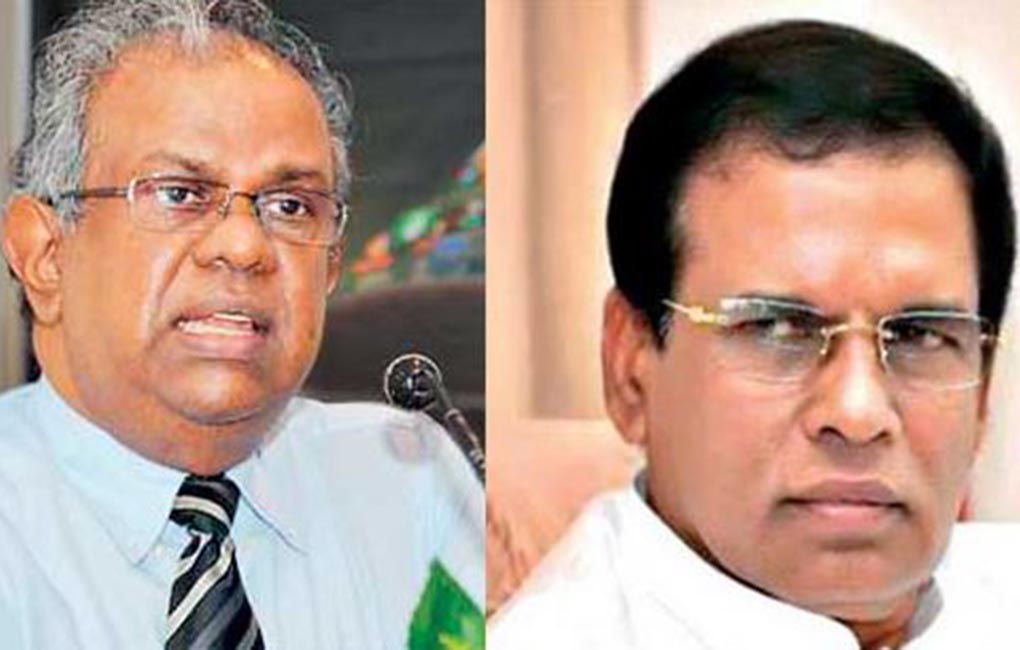
Open letter to President Sirisena
By Chandra Jayaratne
Dear Mr. President,
Doing My Duty as a Citizen Advisor to Refresh Your Memory of Your Own Commitments
I make this submission as an appeal for your kind attention in my capacity as a citizen living by the Lord Buddha’s pronouncement, “A man is not called wise because he talks and talks again; but if he is peaceful, loving and fearless then he is in truth called wise,” and believing that it is my duty to refresh your memory of your own social contracts creating public commitments and earnestly appeal for due accountable delivery of those commitments.
It is usual for you to end your nationwide addresses quoting from the Dhammapada. In that context, I appeal that you kindly refresh your memory with the stanzas 256, and 257 of the Dhammapada from ‘Vinicchayamahamatta Vatthu’ and stanza 252 from ‘Mendakasetthi Vatthu’, where the translations read as follows:
Verse 256: He is not just if he decides a case arbitrarily; the wise man should decide after considering both what is right and what is wrong.
Verse 257: The wise man who decides not arbitrarily but in accordance with the law is one who safeguards the law; he is to be called ‘one who abides by the law (dhammattho). (https://www.tipitaka.net/tipitaka/dhp/verseload.php?verse=256)
Verse 252: It is easy to see the faults of others, but difficult to see one’s own. A man broadcasts the fault; of others like winnowing chaff in the wind, but hides his own faults as a crafty fowler covers himself. (https://www.tipitaka.net/tipitaka/dhp/verseload.php?verse=252)
I kindly appeal to refresh your memory by revisiting the following commitments made by you:
Commitments made by you in your 2015 Presidential Election Manifesto, committing in a social contract with 6.2 million voters that you will uphold democracy, rule of law, justice, ensure effective law enforcement and good governance principles throughout your term of office.
The statement made on April 23, 2015 on the occasion that marked 100 days since election as President, where you stated that “the freedom and democracy that comes with Good Governance should not be abused for personal gain. But our responsibility towards people of the country and for the children born tomorrow must be fulfilled. Every action will be taken to reduce and eliminate corruption and fraud. To this moment I have not made a telephone call or spoken to any officer in the Commission on Bribery and Corruption. I have not spoken to any officer in the judiciary. That is a necessity in good governance. The State sector should be an example to the people.” (http://www.defence.lk/new.asp?fname=The_statement_made_by_President_Maithripala_Sirisena_o April_23_20150424_01”)
In the policy statement made at the opening of the Parliament on 1 September 2015, you committed to ensure that the “elimination of corruption and protection of state property was a main aspiration articulated in the mandate that the majority of Sri Lankans gave to my manifesto ‘Maithri Governance’ led by the principles of good governance. Therefore, the commitment to eradicate corruption and fraud remains a key principle of my government. I will not hesitate to take action to take those who are charged with abuse of state property before the Judiciary, whatever their status or affiliations may be. I am committed to further strengthen the existing institutional structures to eradicate corruption.”
Your expressed commitments, as signaled by your attendance and endorsement of the communiqué arising from the Anti-Corruption Summit in London in May 2016, where you made significant commitments to root out corruption from the country by establishing an anti-corruption secretariat, a special presidential commission and a commission to investigate allegations of bribery and corruption, together with the establishment of a special division within the police titled Financial Crimes Investigation Division (FCID) to expedite investigations on major financial crimes.
Your commitments made during the National Summit on Anti-Corruption in Sri Lanka in December 2016.
Your commitments during the Open Government Partnership Global (OPG) Summit in Tbilisi, Georgia in 2018. (http://www.ft.lk/news/SL-
stepped-up-to-break-link-between-power-and-corruption--Sirisena/56-659471)
Your commitment during the address as the Chief Guest of the Global Expert Group Meeting on the Jakarta Principles in Colombo to make Sri Lanka the number one country in the world, in the fight against corruption this morning (July 25 2018) (https://www.newsfirst.lk/2018/07/26/sri-lanka-and-the-fight-against-corruption-2/)
Having considered some of your Commitments noted above, I appeal that you, as the President and the minister in charge of Law Enforcement and Police, immediately Issue an Executive Order, binding on all members of the Executive, to strictly adhere to the following:
All pending legal action, pending prosecutions, investigations and intelligence gathering, be continued unabated, with integrity and commitment to the highest professional standards using international best practices, by all in law enforcement including the Police, Independent Commissions, Regulatory Authorities, Special Presidential Commissions, Special Presidential Task Forces, Financial Intelligence Unit and the Attorney Generals Department, irrespective of whether these investigation or prosecutions relate to periods pre- or post-January 2015.
All pending legal action, all pending prosecutions, all pending appeals, investigations and intelligence gathering involving:
Illegal and unauthorised transfer of state assets exceeding Rs. 500 million
All corruption investigations where the loss to the State exceeds Rs. 500 million
All bribery investigations involving Rs. 100 million or above
All criminal breach of trust, misappropriations, computer crime, proceeds of crime and fraud investigations involving amounts in excess of Rs. 1 billion.
All anti-money laundering investigations exceeding $ 2 million or equivalent in rupees or other currencies.
All high-profile murder, abduction and violence linked investigations and prosecutions be duly prioritised and necessary resources, human and physical, be allocated to ensure the earliest conclusion of investigations and prosecutions, with progress thereon being reported to the Inspector General of Police and Attorney General, once in every two months.
Any of the officers assigned for or engaged in carrying out any of investigation and prosecutions as specified under Sections 1 and 2 above be not subject to transfer or reassignment, during the next two years, without the prior special approval of the National Police Commission or the Judicial Services Commission.
All pending legal reforms and new enactments planned, including the proposed Proceeds of Crime Act and all other administrative or regulatory requirements essential to meet international ratings or other compliance stipulations, be completed and presented to the Parliament and other authorities at the earliest option.
Under no circumstances should any officer engaged in any tasks or accountabilities set out in 1 and 2 above be subjected to undue pressure, harassment or be directed to not pursue their accountability with diligence or be subjected to any other form of unacceptable oversight control or direction and where such instances are observed the relevant violators must promptly be dealt within the law and regulations in place.
The revenue authorities, (including Inland Revenue, Customs and Excise) and all regulatory authorities, Financial Intelligence Unit and Secretaries of Ministries be directed to assist (including requests for information, progress assistance and other requests emanating in connection with 1 and 2 above) in any way to ensure timely and comprehensive completion of all pending investigations and prosecutions.
All persons appointed to high posts must be pre-cleared by the empowered appointers to ensure that such new appointees are not persons who are subject to investigations nor are suspects or possible suspects in pending investigations and prosecutions.
Yours Sincerely,
Chandra Jayaratne
*The writer is a good governance activist and a past Chairman of Ceylon Chamber of Commerce (CCC).
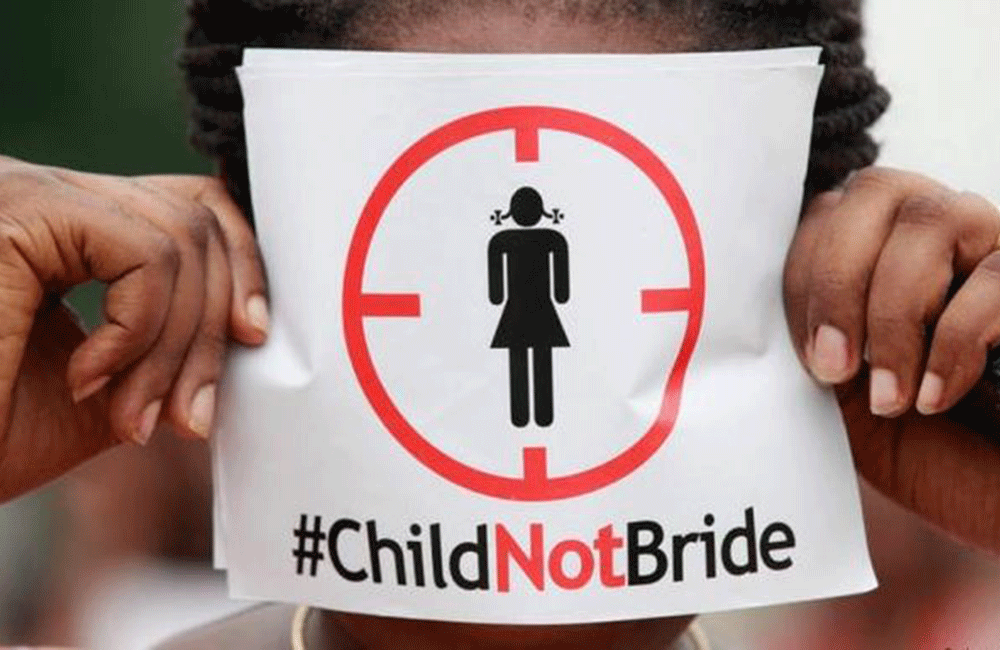
Sri Lankan bid to stop Muslim 12-year-olds from marrying
Zeenath’s parents believed it was best for girls to marry early in the event of a proposal. The 16-year-old had studied hard and obtained a government job with plans to save for a dowry, a traditional payment to the groom and/or his family. But her hopes were thwarted when her father and mother, themselves trapped in a cycle of poverty, decided not to wait.
Instead, they influenced Zeenath to quickly marry a man of similar age to her own father who was not seeking a dowry. She complied with her parents’ wishes with the aim of pleasing them, but paid a high personal price Zeenath, who uses this name to protect her identity, was assaulted regularly; a victim of spite and distorted Islamic practices, whose rights to healthcare and further educational opportunities were denied. Now she has filed for a divorce against her husband and lives with her own child at her parents’ house.
In another shocking Sri Lankan case last year involving early marriage, pregnant Thameem Fatheema Sharmila, 16, was tied to a chair and then had hot oil poured over her body before she was set on fire by her 22-year-old husband.
Sharmila had been unaware that her husband had already married twice beforehand and she suffered mental and physical abuse on a daily basis. Subsequently, Sharmila died from the burns she received.
Such cases are all too common and women rights’ activists have urged the government to officially make public a report on proposed reforms to Sri Lanka’s Muslim Marriage and Divorce Act (MMDA) amid plans to table legislative amendments in parliament.
However, a copy of the report, compiled by a 17-member committee established in 2009 and chaired by Justice Saleem Marsoof, was leaked and is already available on the internet.
The Marsoof report was officially submitted to Justice Minister Thalatha Athukorale on Jan. 22.
“This committee has been conscious of the urgent need to reform the law to eradicate the menace of child marriages and considered the question of fixing a minimum age of marriage for Muslims,” the report states.
It contains a recommendation for a minimum marriage age of 18 for both males and females to apply to Muslims, however this position was not adopted unanimously by the committee.
The majority committee recommendation is for the introduction of uniform marriage and divorce laws applying to all Sri Lankans, irrespective of their religious beliefs.
At present, the nation’s common law doesn’t allow underage marriages, but the law applying to adherents of the Islamic faith allows for the marriage of girls as young as 12. The United Nations and the European Union have urged the government to end such double standards.
The Sri Lankan government has signed the Convention on the Elimination of all forms of Discrimination, which stipulates that women be afforded the right to freely choose a spouse.
Other Marsoof committee recommendations include references to the issue of greater representation of woman in bodies with decision-making powers in relation to marriage, divorce and maintenance payments.
The Marsoof report notes that Muslims have been visiting Buddhist-majority Sri Lanka since at least the 8th century and that many had settled. Muslims now comprise about 9.7 percent of the population of 21 million people on the island nation. The report also makes the point that there is a “myth of homogeneity” of Muslim laws that constitutes a stumbling block to Sharia reform.
Some Muslim women’s groups also advocate reform and there have been various committees of inquiry on the issue since the 1970s.
Juwairiya Mohideen, chairperson of Women’s Action Network, said the law covering Muslim marriages and the country’s Islamic Sharia ‘Qauzi’ courts continue to oppress women and girls. Mohideen, who is also the director of Muslim Women’s Development Trust, said reform delays constitute a denial of dignity, justice and equality.
Her organization conducted a survey in 2016 of early Muslim marriages carried out between 2005 and 2015 in three districts.
In a sample group of 350 married Muslim girls, 254 girls married when they were aged 16 or 17 and 189 early marriages occurred as a result of financial factors, notably the payment of dowries.
Seven marriages had taken place only one year after girls reached puberty and there were a total of 51 marriages, in the survey group, of girls aged between 12 and 16, Mohideen said.
Father Noel Dias, a lecturer at the Sri Lanka Law College, said that the Muslim Marriage and Divorce Act violates both international law and basic standards of human decency.
He accused the government of dragging its feet on the issue because of lobbying by powerful male Muslim leaders opposed to change.
“This proposal to raise the age of marriage is absolutely essential,” said Father Dias, referring to the Marsoof report.
The Sri Lanka Tawheed Jamaath, a Muslim organization, in 2016 held a protest rally against amending the MMDA to raise the minimum marriage age, but some women’s groups have demonstrated in support of reform.
Niranjani Roland/UCN
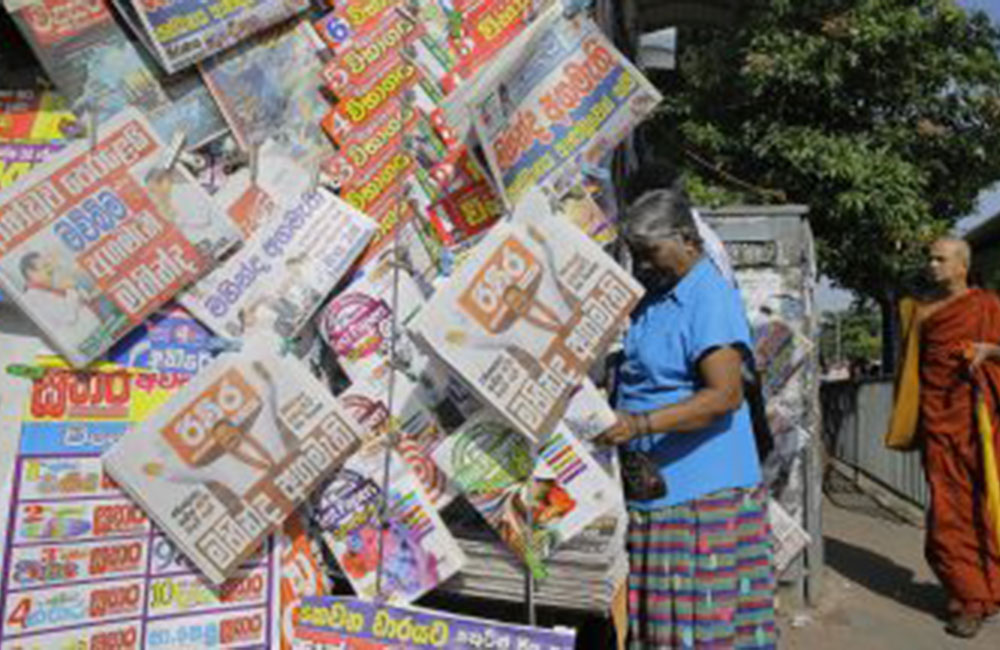
Sri Lanka’s Constitutional Crisis and the Right to Press Freedom
By Tasnim Nazeer
Sri Lanka went into a constitutional coup on October 26, 2018 when President Maithripala Sirisena fired Prime Minister Ranil Wickramasinghe and replaced him with former President Mahinda Rajapaksa. Shortly after Rajapaksa was sworn in as prime minister, supporters of his party invaded Sri Lankan newsrooms to take control of some of the island’s main TV stations and forced journalists to change front pages of their print editions. Dharisha Bastians, editor of the Sunday Observer LK, was even commanded to surrender complete editorial control of the paper. This is what many journalists both in Sri Lanka and around the world feared when control was given back to Rajapaksa, who is well-known for being on the world’s list of worst press freedom predators, according to the organization Reporters Without Borders (RSF), which campaigns for freedom of information.
As a British Sri Lankan journalist myself, I fear for my fellow journalists on the island, some of whom I know have fled the country and some who are in the country and fear for their lives. The people of Sri Lanka have the right to democracy and journalists should not have to be placed in a situation where they have to fear for their lives in reporting in the interest of the public.
Many journalists have disappeared throughout the years when Rajapaksa was president. Others have been killed for holding views that go against the government. After the appointment of Wickramasinghe, many journalists felt they could again voice their opinions more openly, but the sudden reappointment of Rajapaksa leaves not only journalists but minority groups concerned over action that could potentially threaten stability in the country. Concerns over democracy and freedom of media independence are justified and the unjustified reinstatement of the former president brings back dark memories of Rajapaksa’s presidency for many in the industry.
“We cannot forget the state terror against journalists during the rule of Mahinda Rajapaksa,” Deputy Editor of the newspaper Anidda and former head of the Sri Lanka Working Journalists’ Association Lasantha Ruhunage told RSF. “So many journalists were harassed, attacked, and killed. There are reported cases of disappeared journalists.”
It is not only the rights of journalists that have been stripped. What happened to the rights of the people? The people of Sri Lanka should be given the right to choose who they want to govern the land. The people selected Wickramasinghe through a democratic vote and should be entitled to vote again if need be to choose who they want to govern them. Sri Lankan citizens should not have their rights stripped from them; they should not have to be told who is going to be prime minister based on the decision of the current president. The decision should always be with the people of Sri Lanka and this is one reason why there have been mass protests in the country demanding for democracy to be upheld and the parliament to reconvene.
As a Sri Lankan myself, I call on the government to ensure that journalists’ safety and editorial independence is upheld in the country so that news is presented to the public without interference from political authorities.
Frustratingly none of the promises that Siresena made back in 2015 in regards to investigating war crimes and good governance has been upheld. He now has appointed someone who would halt the process of accountability and justice against crimes toward journalists and minority groups on the island.
I stand with my Tamil, Muslim, and Sinhalese brothers and sisters in Sri Lanka to restore democracy and protect the rights of the media in the wake of this tragic constitutional crisis.
Tasnim Nazeer is an award-winning journalist, author, and UN Universal Peace Federation Ambassador. She has written for Al Jazeera English, CNN, BBC, Forbes, Entrepreneur and others. She was awarded the Ibn Battuta Award for Excellence in Media in 2013.
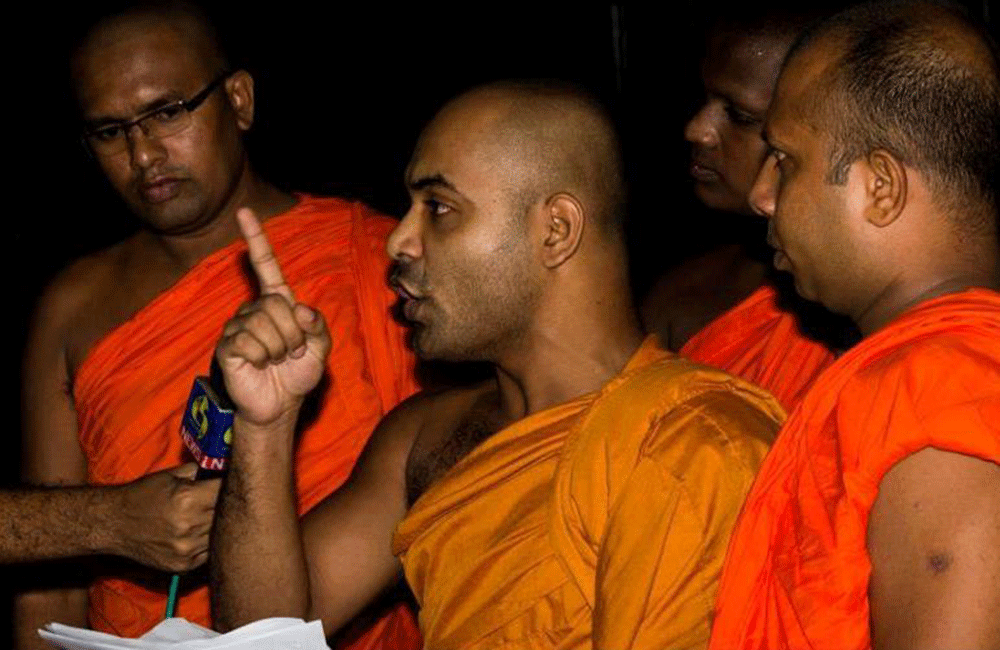
Ultra-nationalist Buddhist rhetoric runs rife in Sri Lanka
By Nursheila Muez and Jessica Yeo Jia Lin
A recent road accident involving a Sinhalese truck driver and four Muslim men in the Kandy district of Sri Lanka quickly spiralled into violent conflict following news that the driver died of his injuries days later. Attacks by mobs on Muslim homes and properties soon after prompted the Sri Lankan government to declare a state of emergency. This recent spate of anti-Muslim attacks in Sri Lanka is neither new nor random. 
Muslim men pray at a ground after a mosque burned down following a clash between two communities in Digana, Kandy. PIC: Reuters
Just like in Myanmar, anti-Muslim sentiment is rising in the country as ultra-nationalist Buddhist rhetoric spreads. One of the key extremist groups in Sri Lanka responsible for such rhetoric is Bodu Bala Sena (BBS).
Formed in 2012, the BBS has been actively ‘defending’ Sinhalese Buddhism by stoking fears that other religious communities pose a threat to the Sinhalese majority. Such rhetoric largely targets the Tamil-speaking Muslim community and to a lesser extent Christians.
Rumours that Muslims are economically superior and will soon outnumber the Sinhalese often circulate online, which causes fear and distrust among the Buddhist majority. Some fear that they will soon be displaced through a Muslim ‘take over’. The BBS has also capitalised on the rise of global Islamist terrorism, using this trend to demonise Muslims in general.
Aside from spreading ‘fake news’ and stoking fear, the group also uses religion to justify its violent actions. Buddhism is articulated through its five precepts, the first of which stipulates that a Buddhist should abstain from killing. Many scholars have argued that recent Buddhist–Muslim clashes in Sri Lanka contradict the humanistic aspect of Buddhism. Ultra-nationalist Buddhist groups like BBS have argued the opposite — that Buddhist texts exist to justify their actions.
A popular historical and religious resource often used is the Mahavamsa, an epic poem that recounts the miraculous visit of Buddha to Sri Lanka. It focusses on the actions of Buddha, King Dutugemunu and King Ashoka. Many ultra-nationalist Buddhists have argued that the passages in the Mahavamsa permit dharma yuddhaya (‘the defence of the dharma’ (the eternal law and order of the cosmos), or ‘just war’) and the text has been used since Sri Lanka’s colonial days to this end.
A portion of the infamous canon details King Dutugemunu’s conversation with the arahants (the living representations of the dharma). The arahants tell the King that he should not feel troubled after killing over 60,000 men. To the arahants, war in Buddhism is justified if it is used in support of the religion’s moral foundations. This same passage was also used by one of Myanmar’s monastic leaders in November 2017 to defend the Myanmar armed forces’ violence against the Muslim Rohingya population.
Another popular mention in the Mahavamsa is of King Ashoka. Some believe that his act of war helped to spread Buddhism to the populations of those cities he conquered. Similarly, the Cakkavatti Sihanada Sutta is used by some ultranationalist Buddhists who believe the text states that violence can be justified in Buddhism if it is used for defence.
This does not at all suggest that Buddhism inherently promotes violence; Sri Lanka’s problems will not be solved by debating whether Buddhists are necessarily violent or benevolent people. Rather, the point is to acknowledge and accept that Buddhists who embrace an ultra-nationalist orientation are — just like extremist adherents of other faiths — people who experience fear, suffering, anger and violence. They may, as a result, turn to their religious texts and traditions to seek justification for their situation.
Religious scholar Scott Appleby posits that there is nothing inherently violent or peaceful about a religious tradition — how a religion manifests itself as violent or peaceful is largely dependent on how its adherents interpret the different resources available to them. This is why terrorists and peacemakers can coexist and adhere to the same religion. Appleby argues that religion’s ability to incite violence is intimately related to its equally impressive power for peace. It is therefore crucial that the focus in Sri Lanka shifts to the positive resources within Buddhism. Such a shift would help provide a compelling counter-narrative to the exclusivist and ultra-nationalist rhetoric spouted by groups like BBS.
In this context, civil society groups have a role to play in adopting moderate and humanistic teachings of Buddhism. A number of Sinhalese Buddhist leaders have already denounced the ongoing riots, but this move needs to be supplemented with a more long-term strategy of promoting religious resources for peace. Beyond Sinhalese Buddhists’ promoting a positive counter-narrative, it is also crucial that ultra-nationalist Buddhist groups re-think their attitude towards moderate Buddhist institutions, minority religious groups and the Sri Lankan state. For the country to move forward and to sustain the peacebuilding process, all of Sri Lanka’s institutions need to work closely together.
Nursheila Muez is a research analyst and Jessica Yeo Jia Lin is a student research assistant in the Studies of Inter-Religious Relations in Plural Societies Programme at the S. Rajaratnam School of International Studies (RSIS), Nanyang Technological University, Singapore.
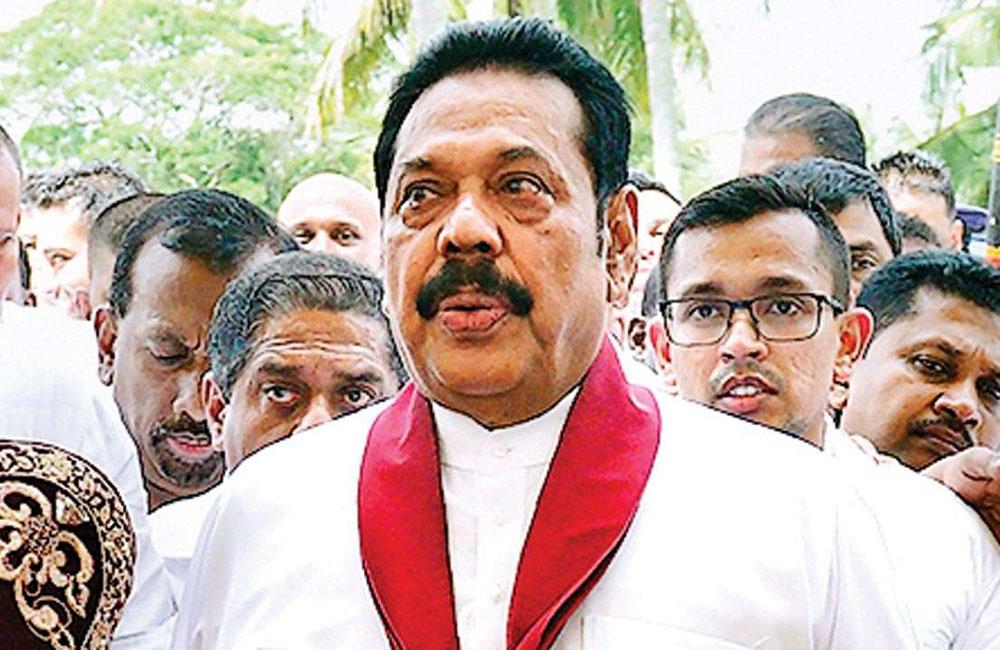
Sri Lanka's Constitutional Crisis: Rajapaksa's Dark Past Shapes the Present
By Taylor Dibbert
Sri Lanka is experiencing a profound crisis. President Maithripala Sirisena has appointed Mahinda Rajapaksa as prime minister. The coalition government is a thing of the past. Ranil Wickremesinghe remains the legitimate prime minister and it’s not clear what happens next.
Sirisena has suspended parliament and it’s not clear when the legislative body will reconvene. It’s confusing because there’s been a lot of conflicting reporting and misinformation about changing the date. Initially, Sirisena had suspended parliament until November 16.
Thursday, reports noted that parliament would be reconvened on November 5. November 7 and then November 16 were mentioned Friday. It’s hard to tell if November 16 will be a firm date or not. It’s also worth noting that the speaker, Karu Jayasuriya, could reconvene parliament before then, but we aren’t there yet, unfortunately.
Really, Rajapaksa or Wickremesinghe should have to prove that they have majority support in the legislative body right now. Chaos and delay favor coup supporters.
It’s important to realize that, no matter what happens, Rajapaksa’s behavior is still quite unacceptable. He hasn’t earned the right to be prime minister even if he were to win a no confidence vote. And he really doesn’t even deserve a no confidence vote because his appointment was completely unconstitutional to begin with. This is an attempted coup.
Rajapaksa’s dark, authoritarian past is shaping Sri Lanka’s present.
There’s already been a bit of political violence and there could be a lot more. Of course, Rajapaksa and his supporters are already very familiar with political violence.
Rajapaksa has assumed some duties in his purported post as prime minister. He’s behaving as if he’s prime minister. With Sirisena’s help, he’s bullied his way into this position.
Rajapaksa’s supposed appointment illustrates a variety of things: that an alleged war criminal and ethnonationalist par excellence remains a powerful political force; that Sirisena has never even vaguely resembled the reformer that many claimed he might be; that Sri Lanka’s democratic gains in 2015 were a lot more tenuous than many believed; that addressing the country’s deep structural problems and issues pertaining to the civil war is probably out of the question for the foreseeable future.
However flawed, Sri Lanka has always been a democracy. There have always been peaceful transfers of power. That could be changing.
Much remains unknown and there are many reasons to be worried. On the other hand, I have noticed something significant and moving. Many brave and thoughtful Sri Lankans – from all walks of life – are speaking out. Thousands of people have already taken to the streets and more of that is sure to come.
I watched one woman on television; she was saying that people were really upset and that they weren’t going to let this illegal transfer of power happen on their watch. It was powerful.
The next few weeks are hugely important for Sri Lanka.
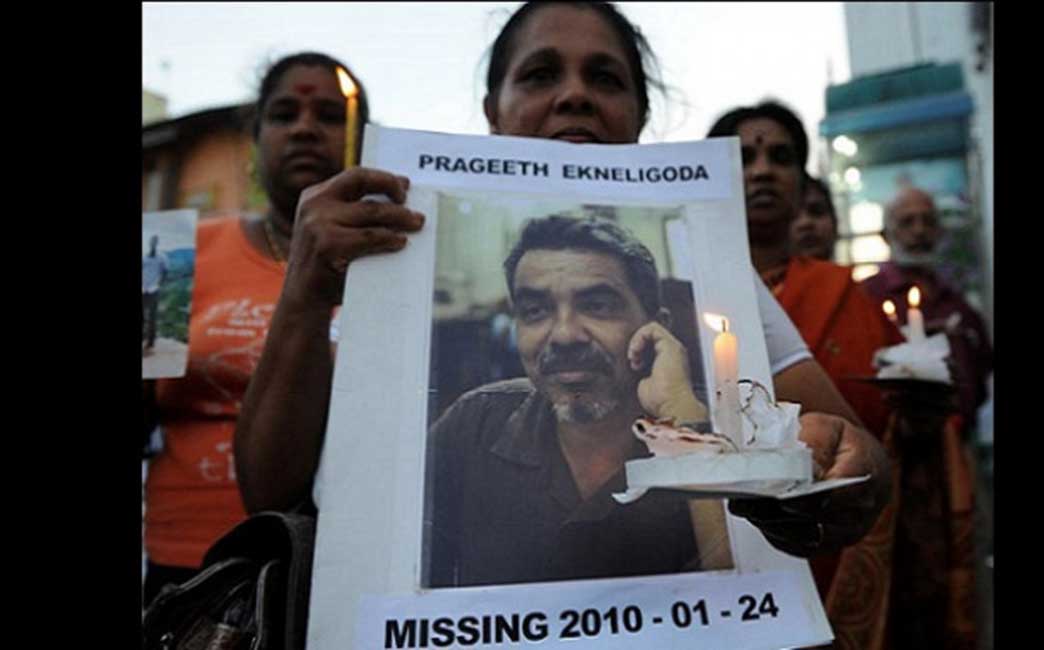
Press Freedom & Enforced Disappearances: Two Sides of the Same Coin in Sri Lanka
By Kanya D'Almeida
When Sri Lankan journalist Richard de Zoysa was abducted from his home in Colombo on the night of February 18th, 1990, his family knew there would be dark days ahead. The population was still reeling from one of the bloodiest episodes in the island nation’s history – a government counterinsurgency campaign to crush a Marxist rebellion in southern Sri Lanka, which left between 30,000 and 60,000 people dead at the hands of government death squads.
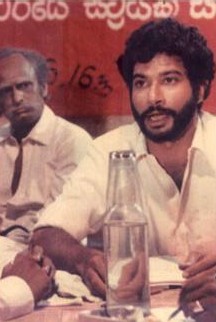 The late Richard de Zoysa, former IPS UN Bureau Chief in Sri Lanka.
The late Richard de Zoysa, former IPS UN Bureau Chief in Sri Lanka.
Even more disturbing than the extrajudicial killings was the wave of enforced disappearances that took place between 1988 and 1990: tens of thousands of Sinhalese men and boys suspected of being members or sympathizers of the People’s Liberation Front, or JVP, went missing, never to return.
At the time of his kidnapping, de Zoysa was a stringer for this publication, filing regular reports on the political violence plaguing the country. He was on the verge of accepting the post of Bureau Chief of the agency’s Lisbon-based European desk when the goons came knocking.
For hours that bled into days, his mother, Manorani Saravanamuttu had no idea what had become of him. High-ranking officials assured her that he was alive, in police custody, but refused to give her exact coordinates when she asked to be allowed to bring him some clothing – he had been wearing only a sarong when he was kidnapped – or a meal.
It later transpired that while she was making frantic phone calls and searching for answers, de Zoysa was already dead, shot in the head at point blank range, and his body dumped in the Indian Ocean, a tactic that had become a common feature of the government’s systematic abductions.
A fisherman happened to recognize his face – de Zoysa was also a well-known television personality at the time – when his body washed up on shore in a coastal town just south of the capital. He alerted the authorities who in turn contacted de Zoysa’s mother.
According to a 1991 Washington Post interview with Saravanamuttu, the discovery of her son’s body was a turning point, for her personally, and for the nation as a whole. When she walked out of the inquest a few days after de Zoysa’s abduction, she found herself surrounded by reporters, to whom she made a statement that resonated with countless families across the island: “I am the luckiest mother in Sri Lanka. I got my son’s body back. There are thousands of mothers who never get their children’s bodies back.”
Mothers of the Disappeared
Saravanamuttu’s statement quickly catalyzed a movement known as the Mother’s Front, which had been a long time coming. Perhaps due to her privileged status as a member of the country’s English-speaking elite, she became a kind of totem pole around which women from the poorer, politically marginalized and largely Sinhala-speaking rural belt could gather, and from which they could draw strength. By 1991, according to the Post, the Mother’s Front counted 25,000 registered members.
The movement did not succeed in bringing justice to many of its victims. To this day, not a single person has been convicted for de Zoysa’s murder. Ministers who opposed Saravanamuttu and others’ attempts to seek answers in the murders or disappearances of their loved ones continue to hold positions of power within the government – Ranil Wickremesinghe, who the Post quoted as brushing de Zoysa’s murder off as “suicide or something else”, now serves as the Prime Minister, the second-highest political office in the country.
Amnesty International estimates that since the 1980s, there have been as many as 100,000 enforced disappearances in Sri Lanka.
The Mother’s Front movement did, however, make a crucial contribution to the country’s political landscape, one which continues to have ramifications today: it tied together forever the plight of Sri Lanka’s disappeared with the fate of its journalists and press freedom – or the lack thereof.
Exactly 20 years after de Zoysa was assassinated, another journalist’s disappearance prompted a woman to step into the global spotlight, much as Saravanamuttu did back in the 90s. This journalist’s name is Prageeth Eknaligoda, and he was last seen on January 24th, 2010. He telephoned his wife, Sandhya around 10 p.m. to inform her that he was on his way home from the offices of Lanka eNews (LEN), where he was a renowned columnist and cartoonist. He never arrived.
From local police stations all the way to the United Nations in Geneva, Sandhya has searched for answers as to his whereabouts. It is only in the last two years that some information regarding his abduction and detention by army intelligence personnel has been revealed.
Both Saravanamuttu and Sandhya Eknaligoda have received international recognition for their tireless campaigning. In 1990 de Zoysa’s mother accepted IPS’ press freedom award at the United Nations on her son’s behalf, and last year Sandhya was honored with a 2017 International Woman of Courage Award. But back in Sri Lanka, she faces a government and a public that is at best indifferent, and at worst openly hostile to her continued efforts to find her husband.
A New Front: Tamil Women in the North
Sandhya has also been one of the few women, and one of the lone voices, connecting the issue of press freedom with the movement of families of the disappeared led by Tamil women in Sri Lanka’s northern province, where the Liberation Tigers of Tamil Eelam (LTTE) waged a 28-year-long guerilla war against the Government of Sri Lanka for an independent homeland for the country’s Tamil minority.
Since January 2017, hundreds of Tamil civilians have observed continuous, 24-hour roadside protests in five key locations throughout the former warzone – Kilinochchi, Mullaithivu, Trincomalee, Vavuniya and Maruthankerny (Jaffna district) – demanding answers about their disappeared loved ones.
Like the Mother’s Front in the 1990s, this movement too has been several years in the making. When the civil war ended in 2009, some 300,000 Tamil civilians were rounded up and detained in open-air camps, while hundreds of others – particularly men who surrendered to the armed forces – were taken into government custody under suspicion of being members or supporters of the LTTE.
But while the camps have closed and a large number of people reunited with their families, an estimated 20,000 people are still unaccounted for, including those who disappeared in the early years of the conflict, as well as others who have been abducted as recently as 2016 and 2017.
In 2016, Parliament passed a bill to establish an Office of Missing Persons (OMP) tasked with investigating what Foreign Minister Mangala Samaraweera called “one of the largest caseloads of missing persons in the world.”
However, rights groups like Amnesty International raised concerns about the bill, including the government’s failure to consult affected families throughout the process. This past March, the government passed a bill that would, for the first time in the country’s history, criminalize enforced disappearances.
But these cosmetic measures have failed to yield concrete results.
In an interview with IPS, Ruki Fernando, a Colombo-based activist who has been visiting the protests in the northern province, noted that Tamil families’ decision to spend day after day in the burning sun by the side of polluted, dusty highways and roads is indicative of their lack of faith in government mechanisms like the OMP and the judiciary to bring them relief. He also called attention to the dismal levels of support or solidarity they have received from Sri Lanka’s broader civil society, including from English and Sinhala-language media or women’s groups in the capital.
“It’s not fair that these families – particularly elderly Tamil women who are leading the protests – should have to carry this burden alone. They have already suffered heavily during the war – they starved in bunkers, they didn’t have medication for their injuries, they have lost family members. All these factors have made them physically weak and emotionally vulnerable, yet now they are also shouldering the burden of keeping these protests going.”
He recalls meeting women as old as 70, adding that protestors sometimes don’t have food, and must endure the vagaries of the weather in the arid northern province. Some of the younger women are forced to bring their children with them. And most, if not all of these families, face the additional financial hardship of having lost their primary breadwinner, or losing out on livelihoods in order to participate in the protests for long periods.
“In my memory, such a strong movement led by women, occurring simultaneously in five locations across the North and East, or any region, is unprecedented,” Fernando said. “And yet it has not become a priority for the rest of the country.”
He called Sandhya Eknaligoda’s participation in the protests as a Sinhala Buddhist ally an “exception” to the rule of general indifference, which he chalked up to a combination of political and ideological issues.
“Some people believe these protests are too radical, too politicized, that there should be more cooperation with, and less criticism of, the government,” he explained. But as Fernando himself noted in an article for Groundviews, one of Sri Lanka’s leading citizen journalism websites, Tamil families have met repeatedly with elected officials, including President Maithripala Sirisena, to no avail.
No Closure
Fernando is not the only one to draw attention to Tamil families’ disadvantaged position with regard to both deaths and disappearances.
Another person to make this connection was Lal Wickrematunge, the brother of journalist Lasantha Wickrematunge, former editor-in-chief of the Sunday Leader who was murdered in broad daylight in 2010, and whose killers still haven’t been brought to justice.
Lal pointed to the ongoing investigation by the Criminal Investigation Department into military intelligence officers’ involvement in the kidnapping and torture of former deputy editor of The Nation newspaper, Keith Noyahr – and the arrest earlier this month of Major General Amal Karunasekera in connection with multiple attacks on journalists, including Noyahr, and Lasantha Wickrematunge – as a possible avenue of closure for the families.
According to a recent report in the Sunday Observer, “The assault on former Rivira Editor Upali Tennakoon and the abduction of journalist and activist Poddala Jayantha are also linked to the same shadowy military intelligence networks, run at the time by the country’s powerful former Defence Secretary, Gotabaya Rajapaksa.”
But Lal Wickrematunge told IPS in a phone interview that while his family, along with international rights groups, are “keenly watching the progress of the investigation, which will determine if the government is serious about law and order”, he is concerned about those who may never receive answers – such as the families of two Tamil journalists who were assassinated in 2006.
Suresh Kumar and Ranjith Kumar were both employees of the Jaffna-based Tamil-language daily Uthayan, whose employees and offices have been attacked multiple times, according to the Committee to Protect Journalists.
Other disappeared Tamil journalists whose cases receive scant attention include Subramanium Ramachandran, who was last seen at an army checkpoint in Jaffna in 2007.
For Fernando, the task of keeping the torch lit for Sri Lanka’s dead and disappeared cannot be laid at the feet of their family members alone – it is a responsibility that the entire country must share.
“What we need first and foremost are independent institutions capable of meting out truth and justice and winning the confidence of the families. And secondly, there is a need for stronger support for victims’ families from civil society – activists and professionals like lawyers, journalists and women’s groups.”
“Pushing for answers about what happened, and demanding prosecutions and convictions requires an exceptional degree of commitment,” he added. “Not everyone has the strength to wage such a battle, on a daily basis, against extremely heavy odds.”
*Kanya D’Almeida was formerly the Race and Justice Reporter for Rewire.News, and has also reported for IPS from the UN, Washington DC, and her native Sri Lanka. She is currently completing an MFA in fiction writing at Columbia University, New York. This article is part of a series of stories and op-eds launched by IPS on the occasion of World Press Freedom Day on May 3.
Page 2 of 5
